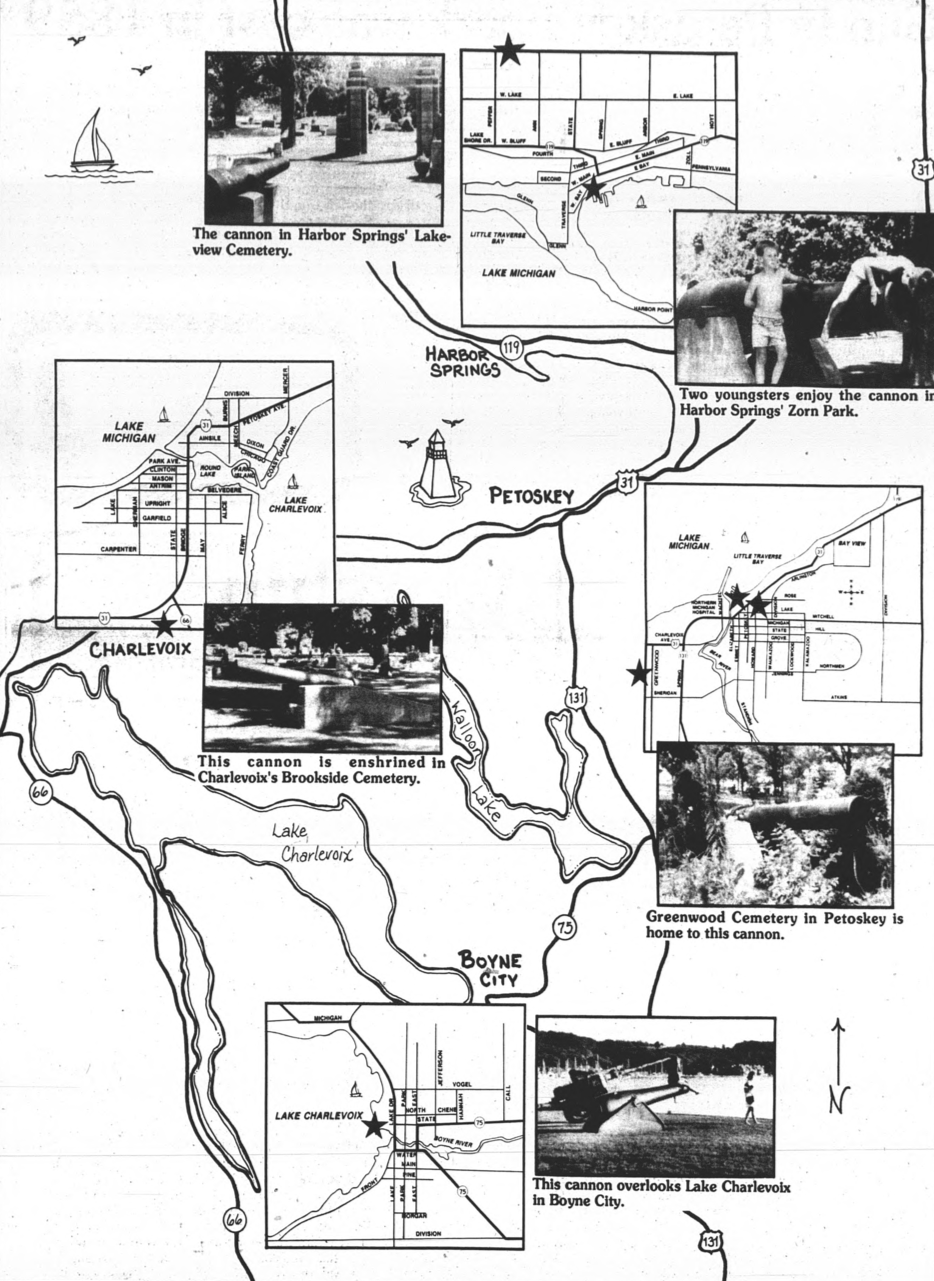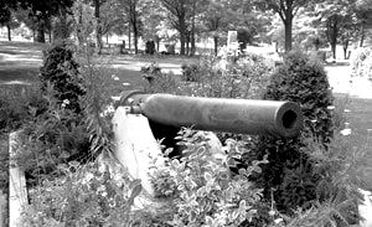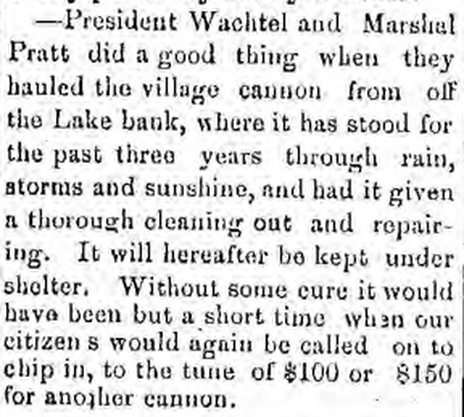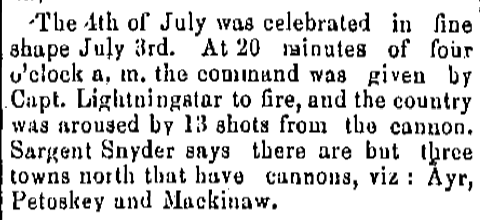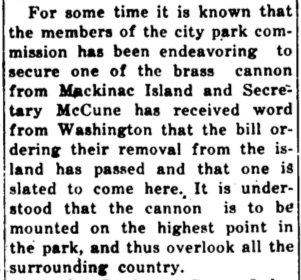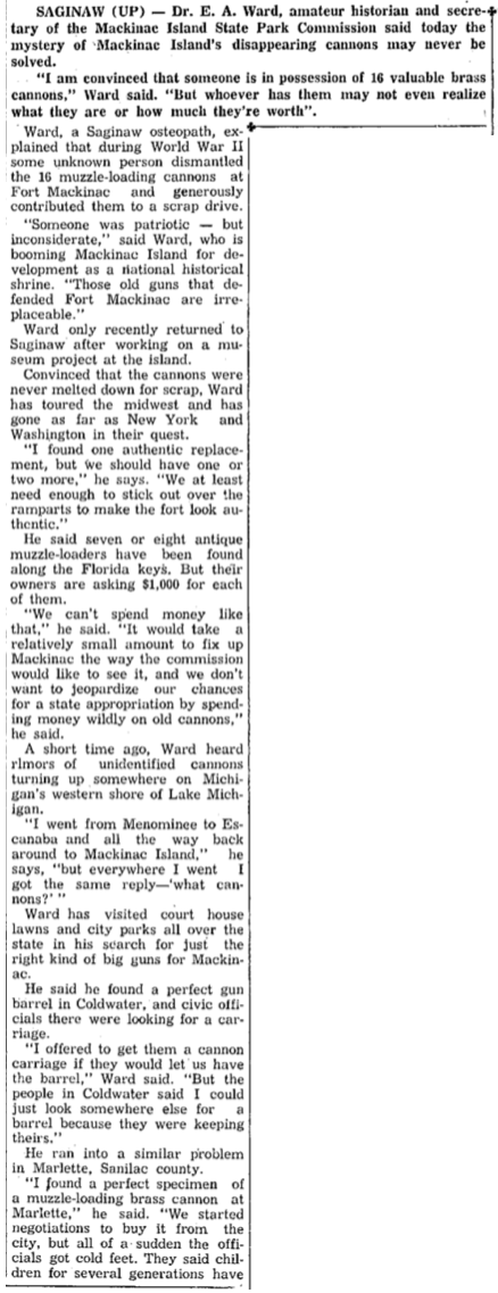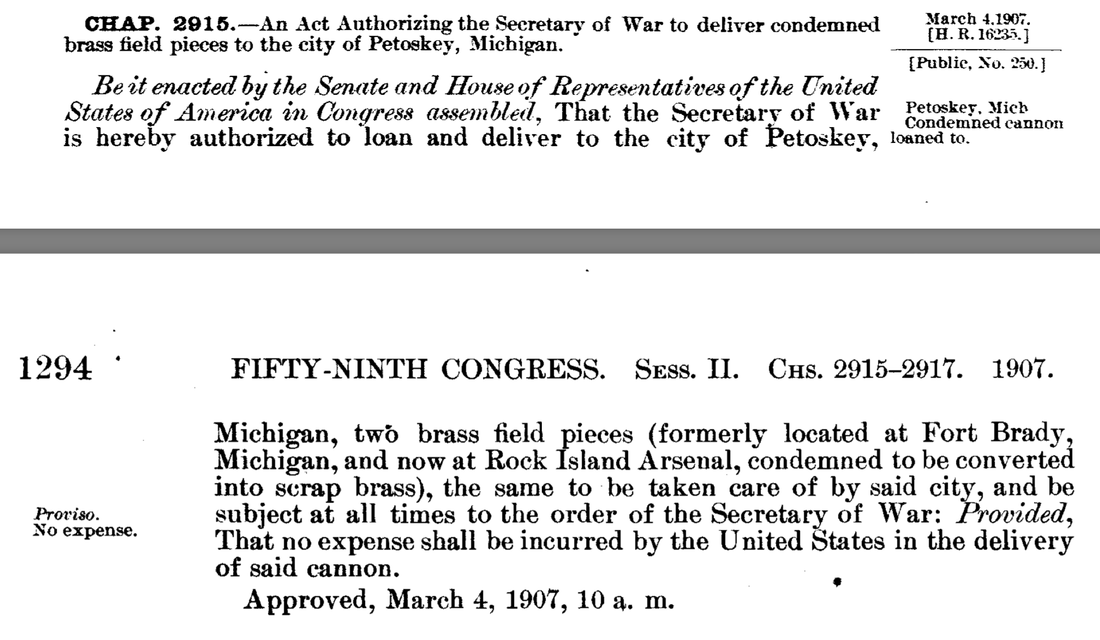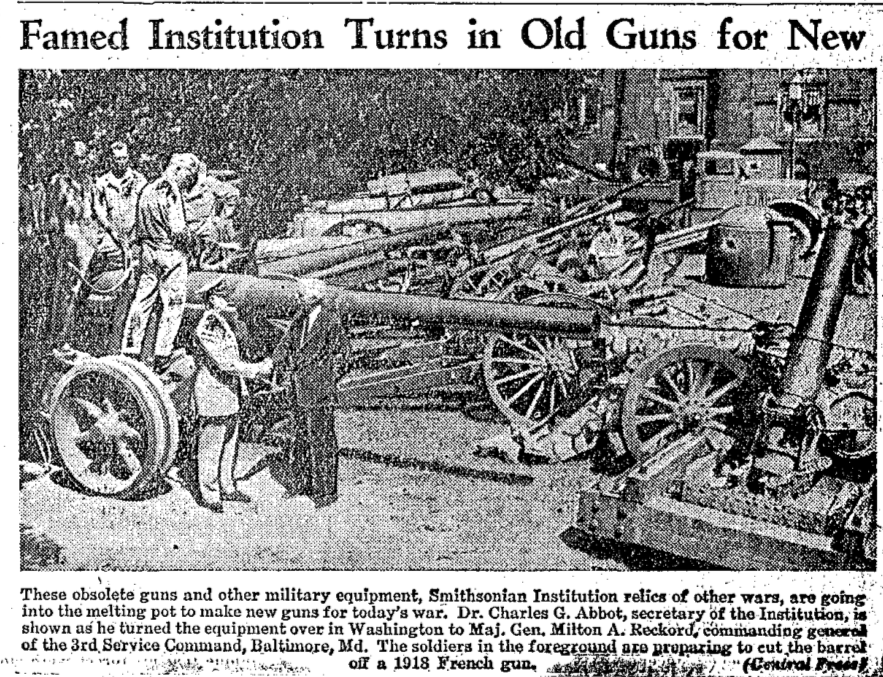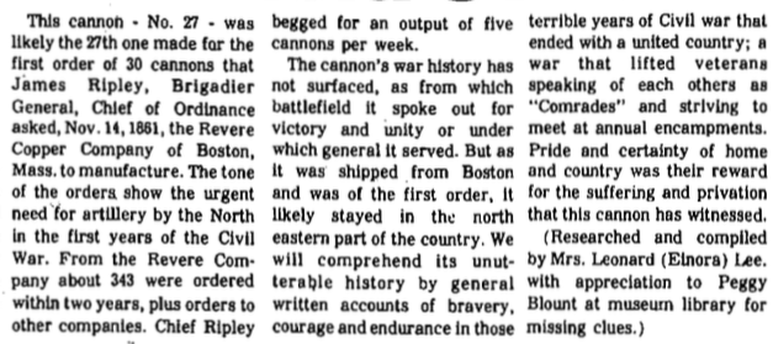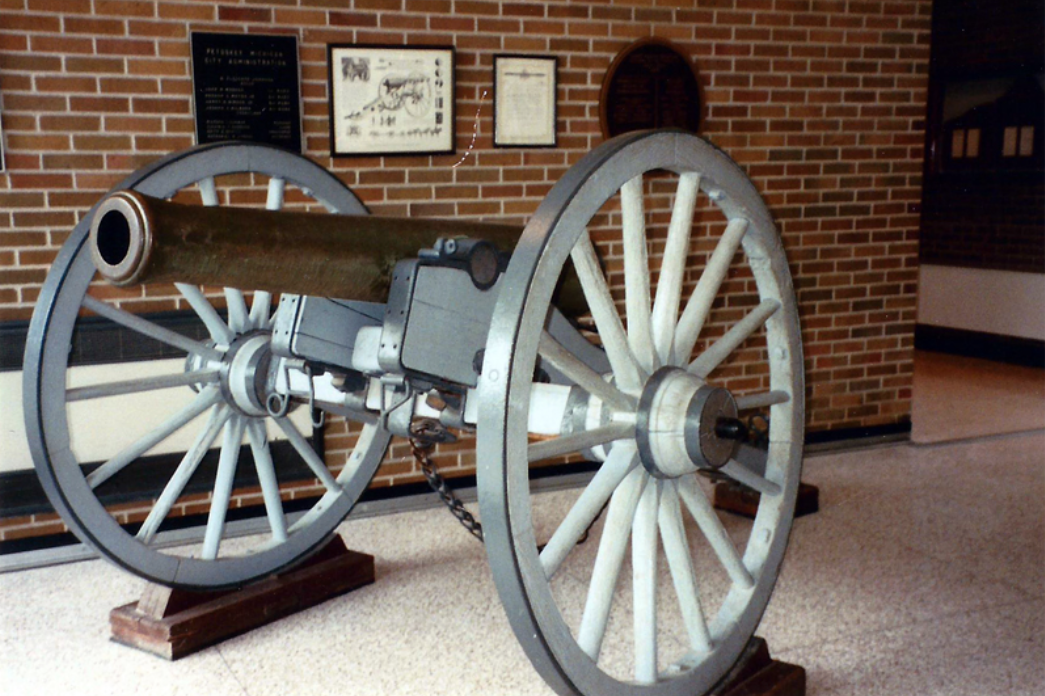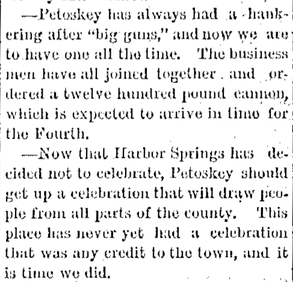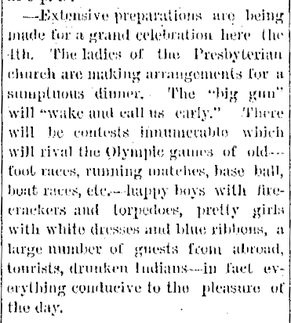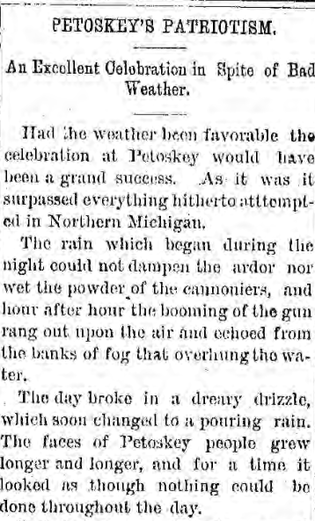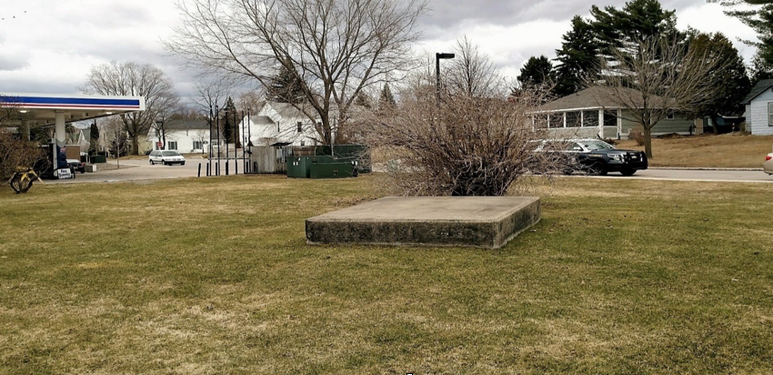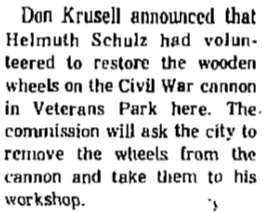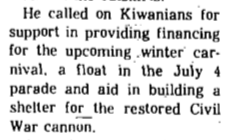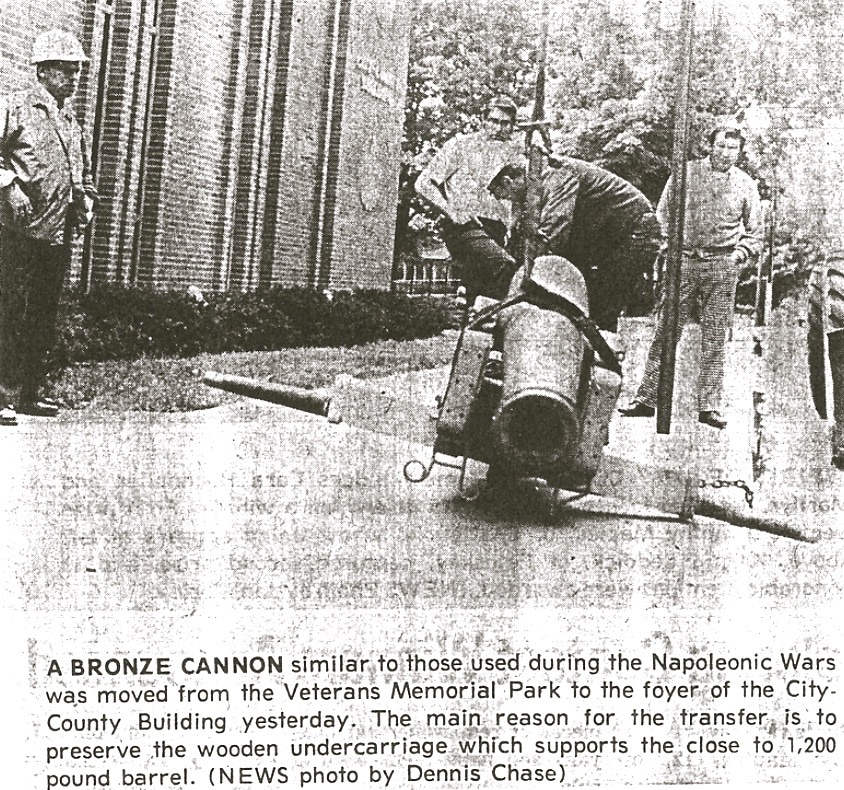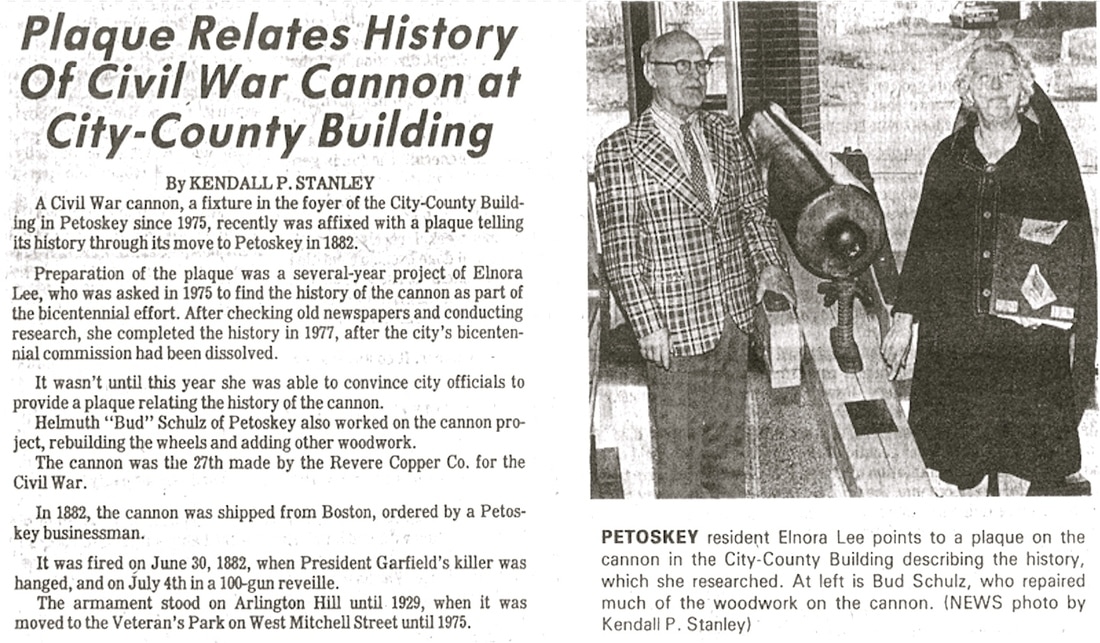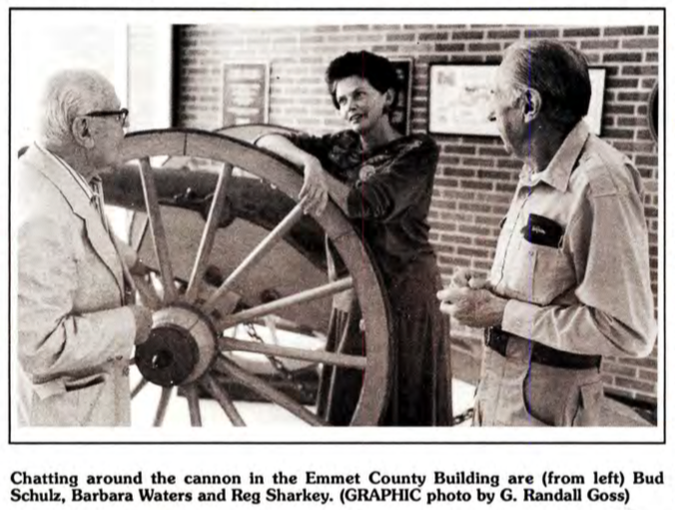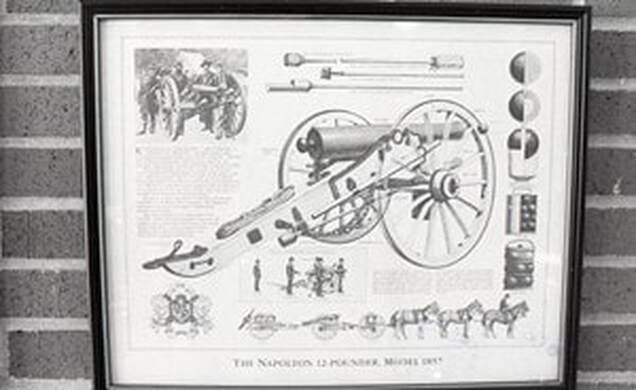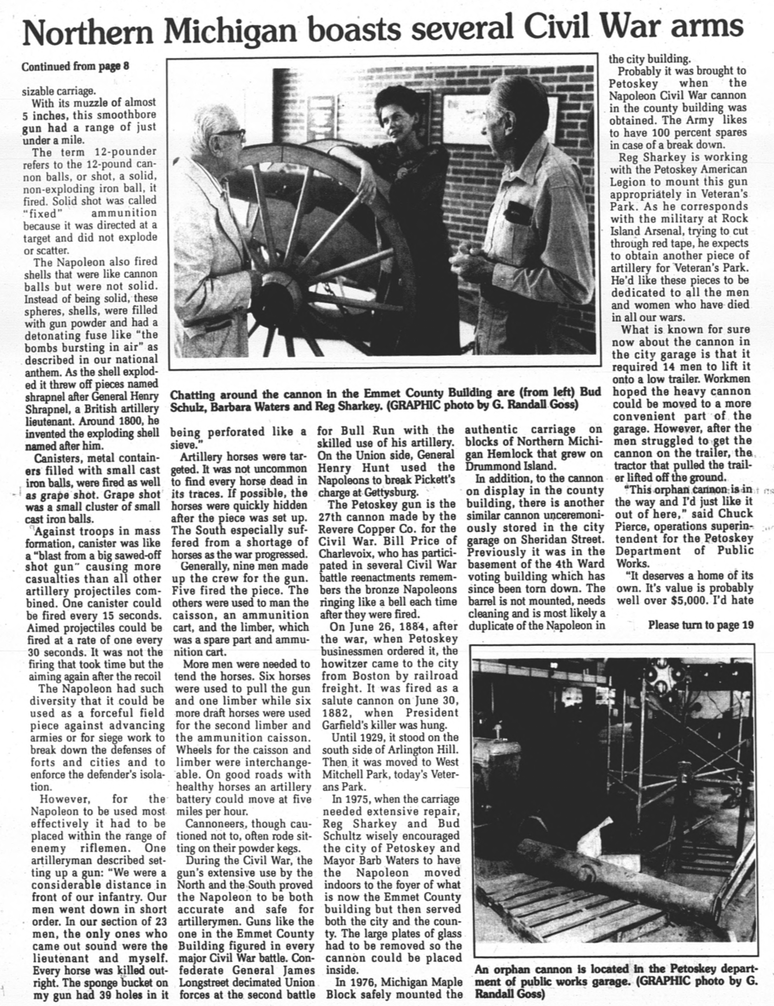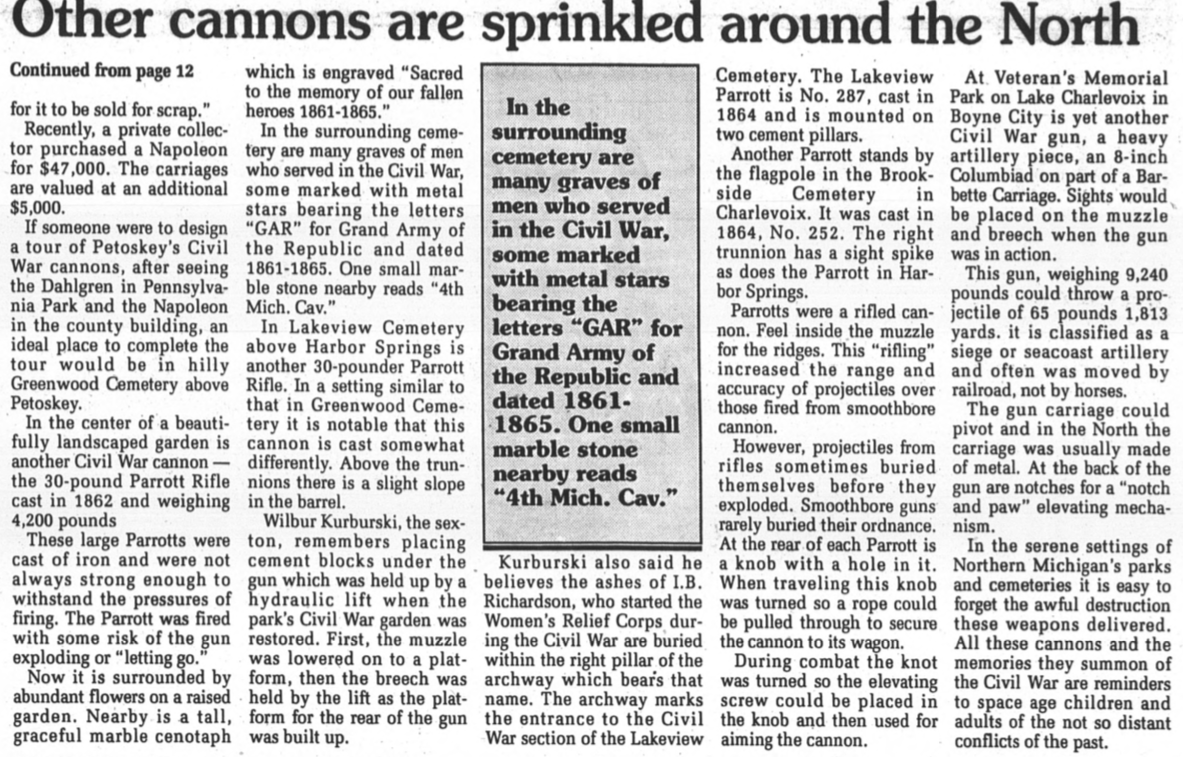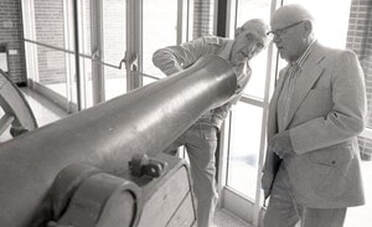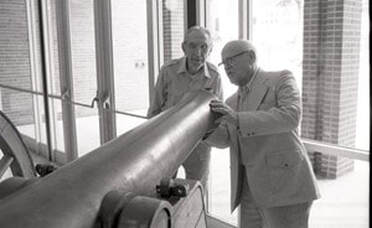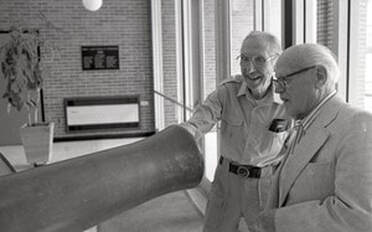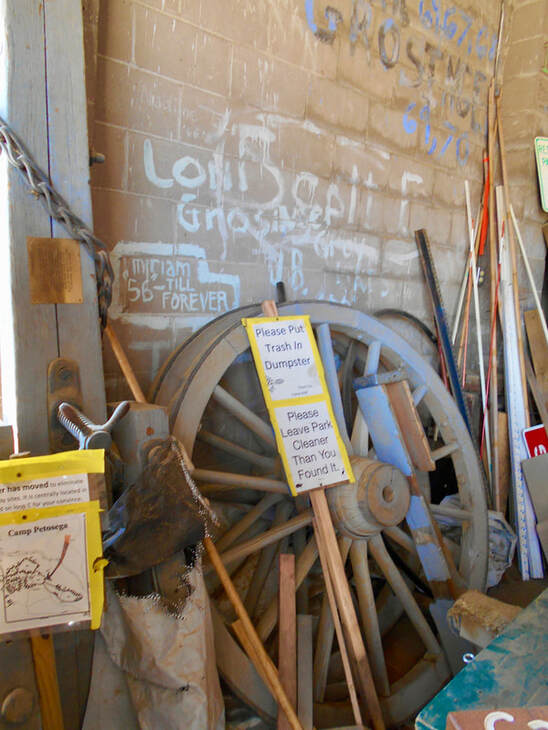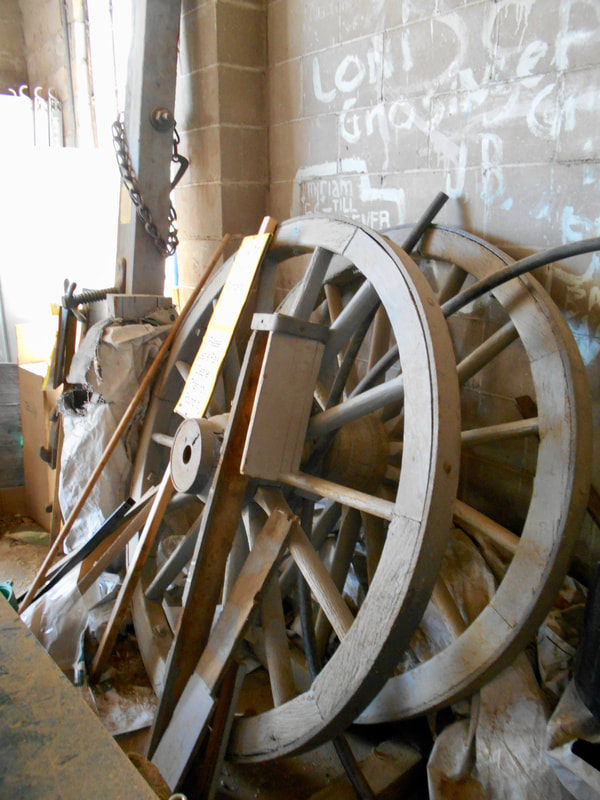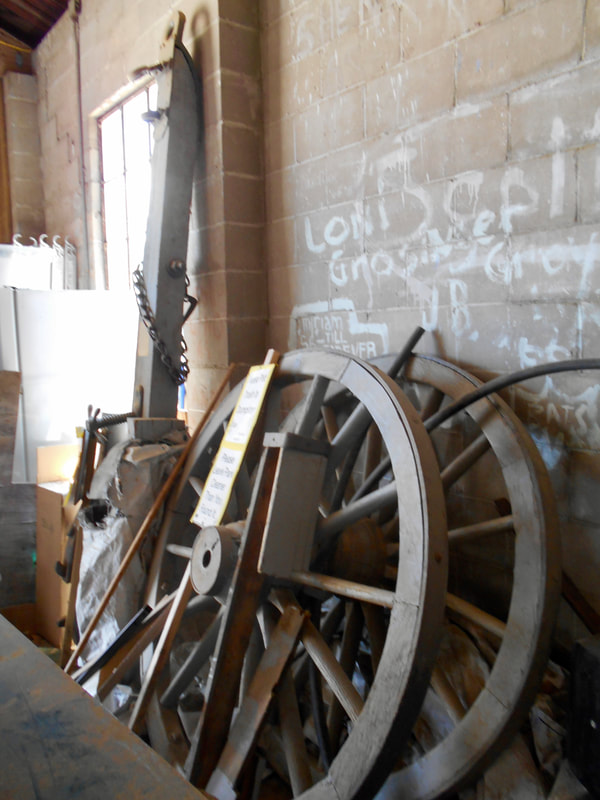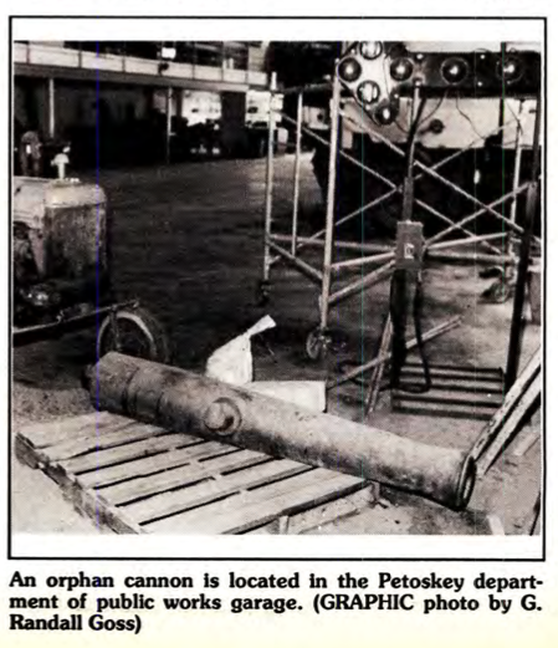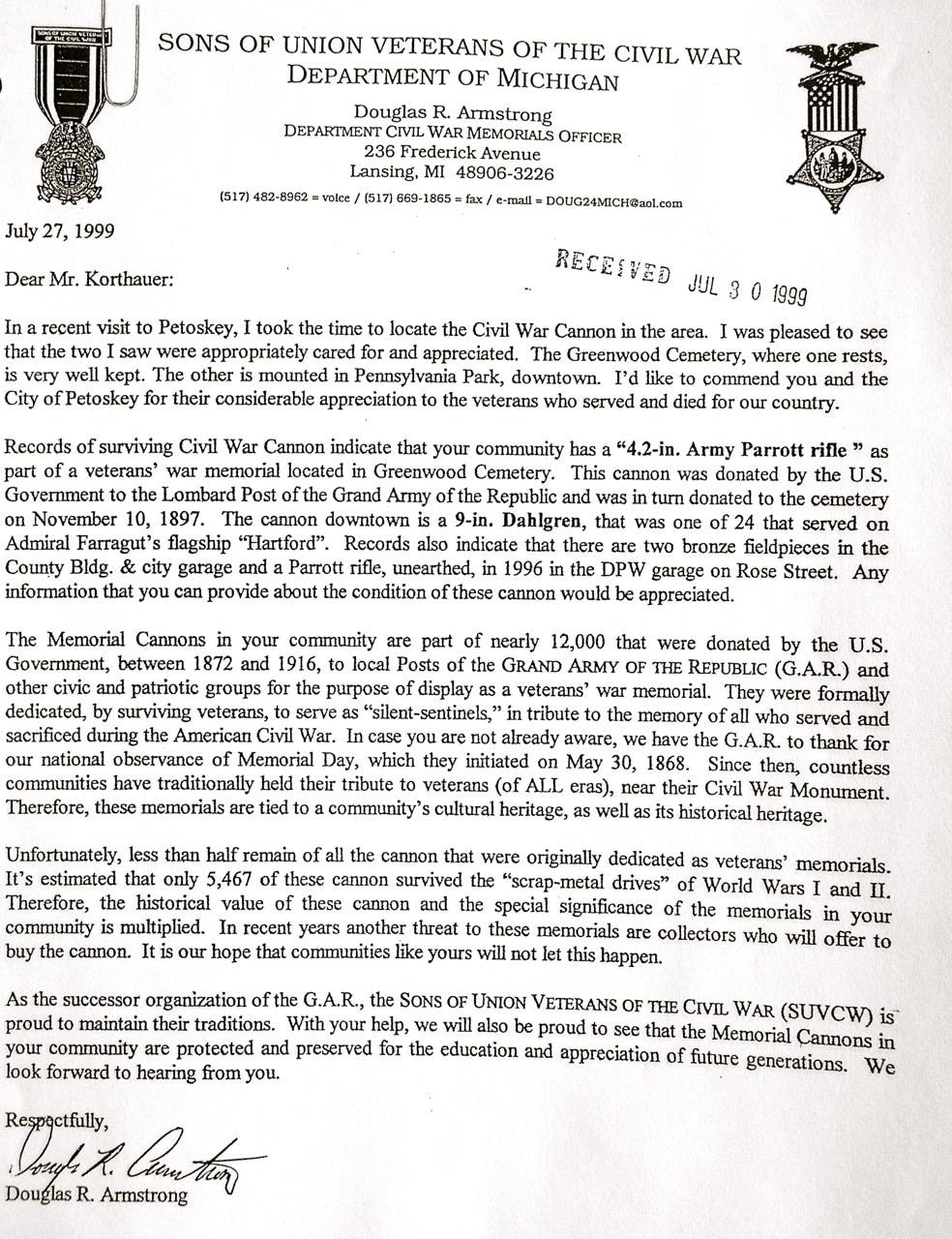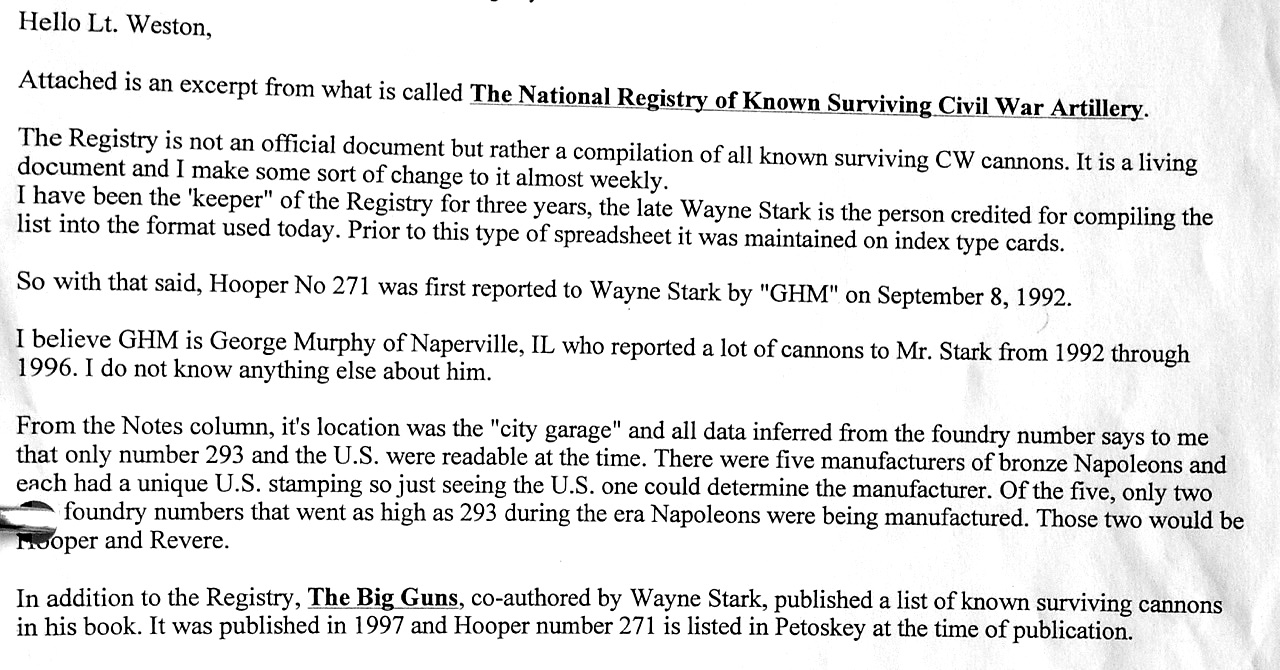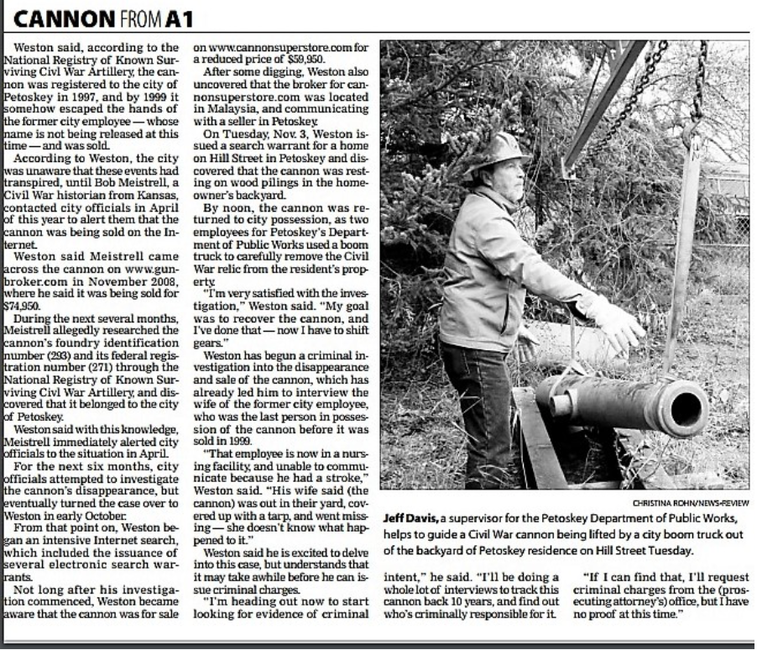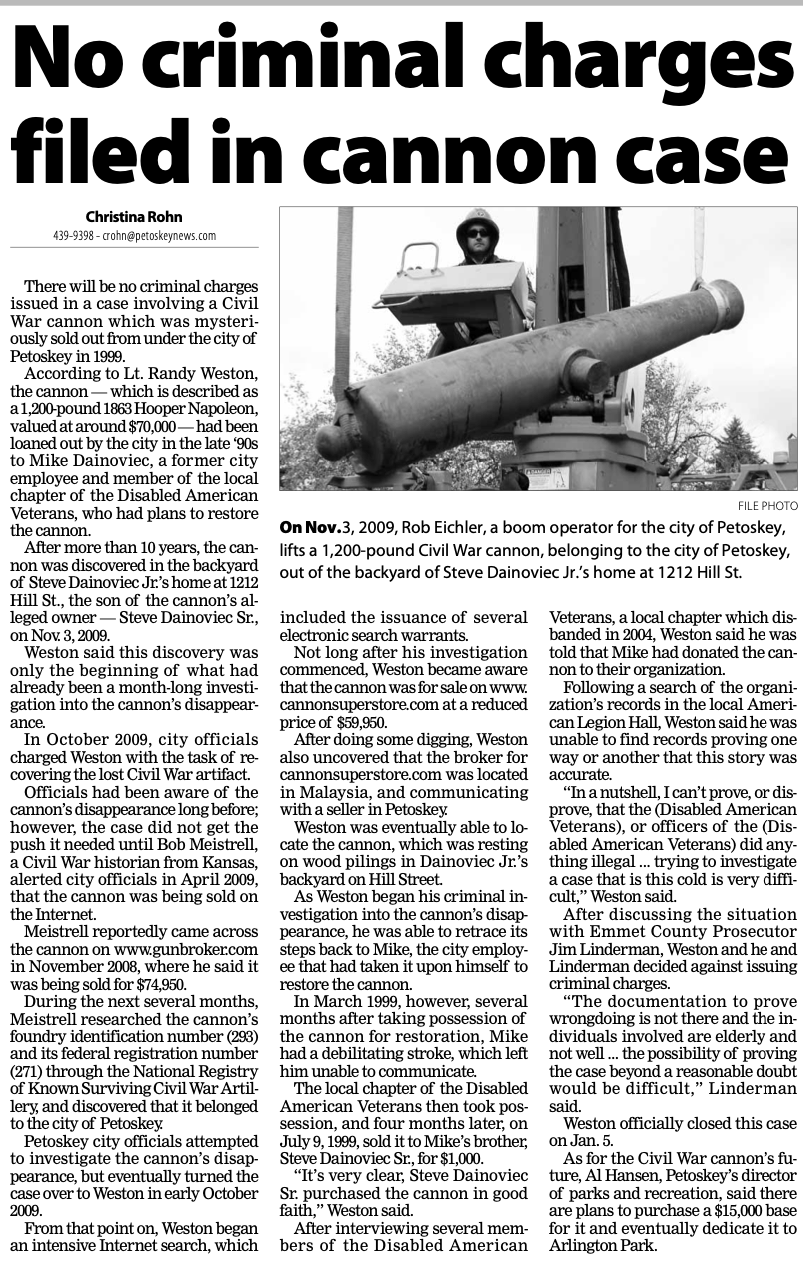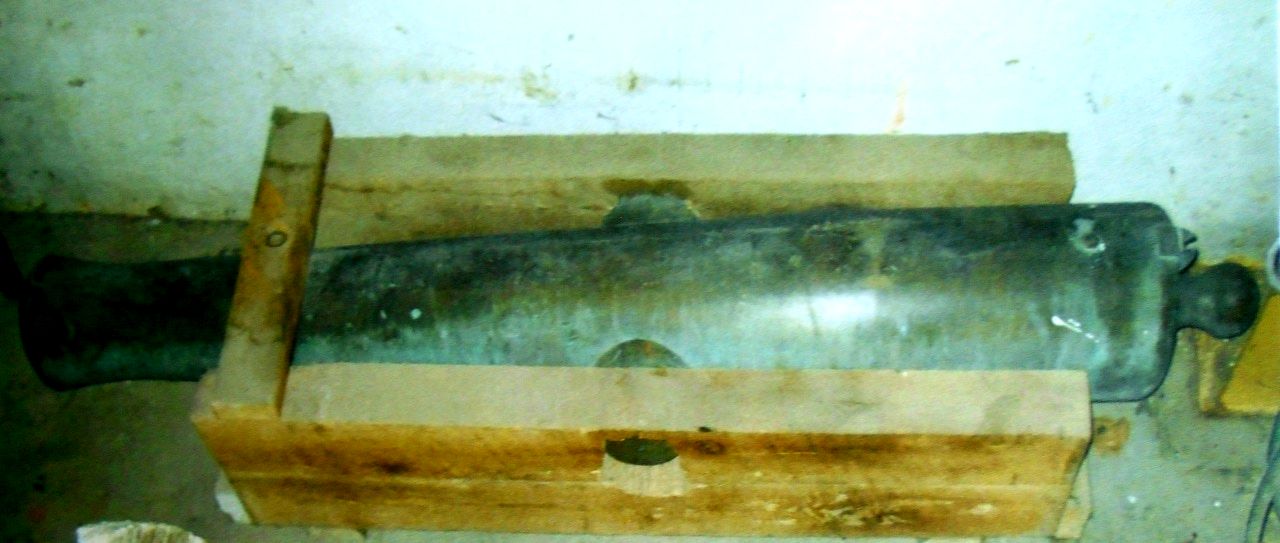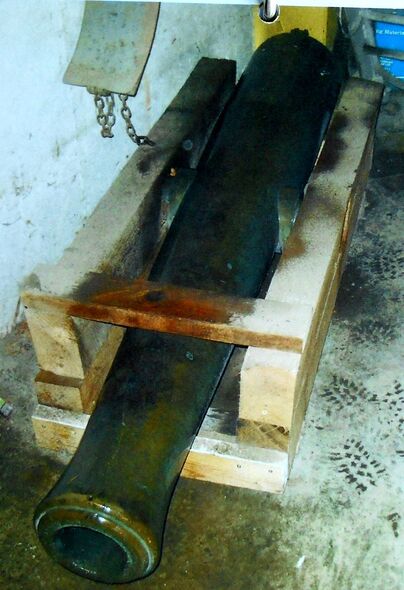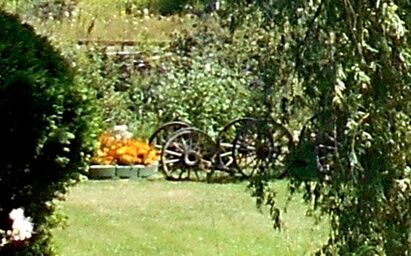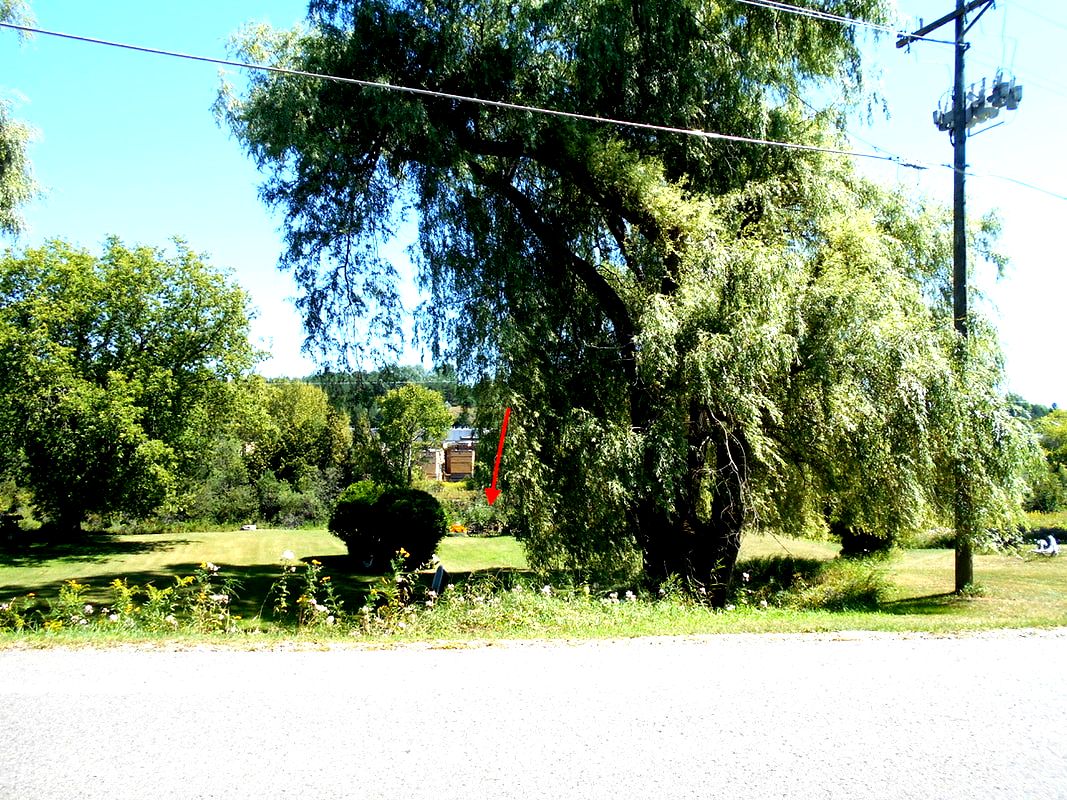~ CANNONS ~
Charlevoix and Emmet
Counties
Charlevoix and Emmet
Counties
Please do not copy the photos on this site, many of which have been submitted by private individuals...
just come back and visit the site often to view the photos.
"Clicking" on some color highlighted words may access additional information;
Most posted items will enlarge by "clicking" on them.
just come back and visit the site often to view the photos.
"Clicking" on some color highlighted words may access additional information;
Most posted items will enlarge by "clicking" on them.
~ Charlevoix County, Michigan ~
The following Charlevoix County cannons have a great deal of information and photos posted on this
Charlevoix Emmet History website.
Some webpages are off-site.
Click on the cannon names below to access the webpages
for the individual cannons.
Charlevoix Emmet History website.
Some webpages are off-site.
Click on the cannon names below to access the webpages
for the individual cannons.
Brookside Cemetery (Charlevoix) ~ 4.2 inch Army Parrott Rifle
Sunset Cemetery (East Jordan) ~ 24 Pounder Iron Flank Howitzer
Veterans Memorial Park (Boyne City) ~ Rodman 8-Inch Gun
Sunset Cemetery (East Jordan) ~ 24 Pounder Iron Flank Howitzer
Veterans Memorial Park (Boyne City) ~ Rodman 8-Inch Gun
~~~~~~~~~~~~~~~~~~~~~~~~~~~~~~~~
~ Emmet County, Michigan ~
The following Emmet County cannons have a great deal of information and photos posted on this
Charlevoix Emmet History website.
Click on the cannon names below to access the webpages
for the individual cannons.
These cannons listed at the top, directly below, may be viewed in the particular locations as noted.
Charlevoix Emmet History website.
Click on the cannon names below to access the webpages
for the individual cannons.
These cannons listed at the top, directly below, may be viewed in the particular locations as noted.
Arlington Park (Petoskey) ~ Napolean Howitzer Confederate Cannon
Cannon Park in Greenwood Cemetery (Petoskey) ~ 30-pounder Parrott Rifle
Lakeview Cemetery (Harbor Springs) 30 pounder Army Parrott Rifle
Mackinaw Marina Park (Mackinaw City) ~ Three IX-inch Dahlgren Shell Guns
Pennsylvania Park (Downtown Petoskey) ~9" Cannon From Flagship "Hartford"
Zorn Park (Harbor Springs) ~ IX-inch Dahlgren Shell Gun Cannon
Petoskey locations not accessible, as noted on this same webpage.... look below:
~ Napoleon 12-Pounder, Model 1857
~ Hooper Napoleon Cannon registry #271 FDRY 293
Cannon Park in Greenwood Cemetery (Petoskey) ~ 30-pounder Parrott Rifle
Lakeview Cemetery (Harbor Springs) 30 pounder Army Parrott Rifle
Mackinaw Marina Park (Mackinaw City) ~ Three IX-inch Dahlgren Shell Guns
Pennsylvania Park (Downtown Petoskey) ~9" Cannon From Flagship "Hartford"
Zorn Park (Harbor Springs) ~ IX-inch Dahlgren Shell Gun Cannon
Petoskey locations not accessible, as noted on this same webpage.... look below:
~ Napoleon 12-Pounder, Model 1857
~ Hooper Napoleon Cannon registry #271 FDRY 293
According to the 1886 article above, the village of Ayr (in Northern Emmet County) had a cannon, like Petoskey and Mackinaw, that shot 13 shots! If anyone has any idea as to the whereabouts of this Ayr cannon, please contact this webmaster by clicking HERE.
~ ANOTHER CANNON MYSTERY ~
Regarding the article above contact the webmaster:
Did Petoskey receive this cannon?
If so, where is it?
Do any photos of this cannon exist?
Do any other articles, documents, or records exist for this cannon?
Did Petoskey receive this cannon?
If so, where is it?
Do any photos of this cannon exist?
Do any other articles, documents, or records exist for this cannon?
~ ANOTHER CANNON MYSTERY ~
Article Below: ~ The FATE of Some Old Cannons ~
The following Cannons are known to exist in Emmet County,
but are not accessible to the public at the present time.
but are not accessible to the public at the present time.
~ Napoleon 12-Pounder, Model 1857 ~
Also know as: "Gun Howitzer," "Light 12 pounder," "12 pounder Gun, "Model 1857" and most common term "Napoleon"
Also know as: "Gun Howitzer," "Light 12 pounder," "12 pounder Gun, "Model 1857" and most common term "Napoleon"
This 1857 Napoleon 12 Pounder Model 1857 at first was placed at City Park (known as Winter Sports Park location in 2014), but later moved to Veterans Park. Next it was moved to the City/County Building on the corner of Lake Street and Division Street, but it is now "in storage".
Photo Below: The Napoleon 12-Pounder, Model 1857 rested in the foyer of the Emmet County Building for a period of time, beginning in 1975. When the building was renovated some time in the 1990s to enlarge the area of the Register of Deeds office directly behind where the cannon is resting below, however, the space for the cannon was no longer large enough to hold it. The cannon was then dismantled and moved to a storage location, inaccessible to the public. Notice that the pictures hanging on the wall behind the cannon are associated with the cannon. Information and close-up photos of those pictures are posted farther below on this same web page.
The first documentation of the cannon, Napoleon 12-Pounder, Model 1857, in the photo above, was located in the 20 June 1882 Harbor Springs newspaper, The Northern Independent.
|
Article Left: 20 June 1882 ~ The Northern Independent: "Petoskey has always had a hankering after 'big guns' and now we are to have one all of the time. The businessmen have all joined together and ordered a twelve hundred pound cannon which is expected in time for the Fourth." |
The Northern Independent ~ 4 July 1882: The cannon was fired a number of times Friday P.M. as a farewell requiem to Charles J. Guiteau. (From other accounts: he was the assassin who shot President Garfield 2 July 1881, but Garfield, though wounded, lived until 19 September 1881. Guiteau was hanged June 30, 1882.) Quoted from Robert Finch website
|
Article Left: 29 June 1882 ~ The Petoskey City Record: "The 'big gun' arrived from Boston Monday, and was unloaded from the cars Tuesday morning. It weighs about 1200 pounds, and will be shot the first time tomorrow while Guiteau is dangling in eternity. Marcus Covell, brother-in-law of Chas. Carmichael, will probably take charge of the firing. He is an old hand at the business, having served in that capacity in the regular army and long in the military service, and is also a graduate gunner."
|
The two 1883 articles below tell of the Organization of the Petoskey Post GAR in 1883 (The Post disbanded in 1940). The article below right stated: "Mr. J.S. Coffman and the other gentlemen who own the 12 pound gun upon the bluff, kindly offered it for the use of the boys, and J.W. Chilson, an old artillery man, at 1 o'clock fired a salute to the visiting officers of 12 guns."
The bluff referenced in the article below right is described on the Robert Finch Post website:
"Tradition reveals that paths lead one up the valley to old City Park, which became the city Zoo and later, Winter Sports Park. The north hill, about a block west of the north end of Bay View-Ave. was known as Flag Pole Hill in the Park. Here was a flagpole and "No. 27" looking over the top of the hill out onto the bay, as if guarding the city of attack by sea.
John Deschermeier [longtime Petoskey resident] visited the zoo and cannon many times as a lad, and recalls that the cannon was still there in 1928. After that, it was stored with its other tube [probably the Hooper Napoleon Cannon registry #271 FDRY 293 noted toward the bottom of this webpage] until the Veterans Park was created in 1942. There, in wartime and until July 1976, it reminded motorists, that America had given her men to defend our precious country."
The bluff referenced in the article below right is described on the Robert Finch Post website:
"Tradition reveals that paths lead one up the valley to old City Park, which became the city Zoo and later, Winter Sports Park. The north hill, about a block west of the north end of Bay View-Ave. was known as Flag Pole Hill in the Park. Here was a flagpole and "No. 27" looking over the top of the hill out onto the bay, as if guarding the city of attack by sea.
John Deschermeier [longtime Petoskey resident] visited the zoo and cannon many times as a lad, and recalls that the cannon was still there in 1928. After that, it was stored with its other tube [probably the Hooper Napoleon Cannon registry #271 FDRY 293 noted toward the bottom of this webpage] until the Veterans Park was created in 1942. There, in wartime and until July 1976, it reminded motorists, that America had given her men to defend our precious country."
The Northern Independent 8 July 1884 article below exclaims the sounding off of the cannon even during rainy celebrations: "The rain which began during the night could not dampen the ardor nor wet the powder of the cannoniers, and hour after hour the booming of the gun rang out upon the air and echoed from the banks of fog that overhung the water."
Does anyone have a photo to post on this website of when the Napoleon 12-Pounder, Model 1857 cannon was resting in Veteran Park? If so, please contact the webmaster by clicking here.
As Petoskey resident John Deschermeier noted above, the Napoleon 12-Pounder, Model 1857 cannon had been stored from 1929 until it was placed in Veterans Park in 1942, when the park was created, until 1975. Veterans Park is located on 429 Madison Street, Petoskey, Michigan. The photo below of Veterans Park was taken 5 April 2017 by Lt. Weston of the Petoskey Department of Public Safety.
As Petoskey resident John Deschermeier noted above, the Napoleon 12-Pounder, Model 1857 cannon had been stored from 1929 until it was placed in Veterans Park in 1942, when the park was created, until 1975. Veterans Park is located on 429 Madison Street, Petoskey, Michigan. The photo below of Veterans Park was taken 5 April 2017 by Lt. Weston of the Petoskey Department of Public Safety.
The 1 July 1976 article, with photo below, has some inaccurate statements when compared to the actual news articles of records above, but some information like the following is correct: "In 1975 the bronze cannon that had stood in the Veterans Memorial Park was moved to the City-County Building; with the city and county having a joint ownership of the building at that time. Petoskey's first woman mayor, Barbara Waters, was in office from 4 November 1974 until 4 November 1980. She encouraged that relocation of the cannon to a sheltered area, or to have a shelter built. After the city and county agreed, details were worked out. The prime reason the cannon shifted sites was to preserve the wooden undercarriage. The cannon had quite a bit of value even at that time. Helmuth Schulz restored the two wheels, especially the spokes and rims, that were badly in need of repair."
Photo Below:
Bud Schulz, previous Mayor of Petoskey Barbara Waters, and Reg Sharkey each had been instrumental in the City-County Building housing the reconditioned cannon in its foyer.
Bud Schulz, previous Mayor of Petoskey Barbara Waters, and Reg Sharkey each had been instrumental in the City-County Building housing the reconditioned cannon in its foyer.
Sometime in the 1990s the Emmet County building was renovated and involved the Register of Deeds office enlarging into the foyer area. This renovation took up room that the cannon had occupied. The cannon was then dismantled and put into storage in an undisclosed county property, where the following photos were taken on 9 May 2017.
View Slideshow of Dismantled CANNON Below... click photo to pause
The two framed photos that hung over the cannon when it rested in the Emmet County building's foyer are located now in the County Administrator's office area. Those photos/signs show in the photo toward the top of the information on this web page and also in the 27 August 1992 The Graphic above about this Napoleon 12-Pounder, Model 1857. Compare those two framed hanging photos with the following photos which were taken on 9 May 2017.
View Slideshow Below... click photo to pause
In the slideshow above is a photo of
the 1 October 1976 letter from Michigan Maple Block Company
about making bases to mount the cannon. The letter reads:
"HISTORY OF WOOD BLOCKS ON WHICH THIS CANNON IS MOUNTED.
the 1 October 1976 letter from Michigan Maple Block Company
about making bases to mount the cannon. The letter reads:
"HISTORY OF WOOD BLOCKS ON WHICH THIS CANNON IS MOUNTED.
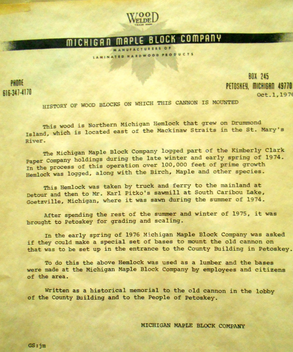 1 October 1976 ~ Letter from Michigan Maple Block Company, Petoskey , Michigan
1 October 1976 ~ Letter from Michigan Maple Block Company, Petoskey , Michigan
This wood is Northern Michigan Hemlock that grew on Drummond Island, which is located east of the Mackinaw Straits in the St. Mary's River.
The Michigan Maple Block Company logged part of the Kimberly Clark Paper Company holdings during the late winter and early spring of 1974. In the process of this operation over 100,000 feet of prime growth Hemlock was logged, along with the Birch, Maple and other species.
This Hemlock was taken by truck and ferry to the mainland at Detour and then to Mr. Karl Pitko's sawmill at South Caribou Lake, Goetzville, Michigan, where it was sawn during the summer of 1974.
After spending the rest of the summer and winter of 1975, it was brought to Petoskey for grading and scaling.
In the early spring of 1976 Michigan Maple Block Company was asked if they could make a special set of bases to mount the old cannon that was to be set up in the entrance to the County Building in Petoskey.
To do this the above Hemlock was used as a lumber and the bases were made at the Michigan Maple Block Company by employees and citizens of the area.
Written as a historical memorial to the old cannon in the lobby of the County Building and to the People of Petoskey.
MICHIGAN MAPLE BLOCK COMPANY"
The Michigan Maple Block Company logged part of the Kimberly Clark Paper Company holdings during the late winter and early spring of 1974. In the process of this operation over 100,000 feet of prime growth Hemlock was logged, along with the Birch, Maple and other species.
This Hemlock was taken by truck and ferry to the mainland at Detour and then to Mr. Karl Pitko's sawmill at South Caribou Lake, Goetzville, Michigan, where it was sawn during the summer of 1974.
After spending the rest of the summer and winter of 1975, it was brought to Petoskey for grading and scaling.
In the early spring of 1976 Michigan Maple Block Company was asked if they could make a special set of bases to mount the old cannon that was to be set up in the entrance to the County Building in Petoskey.
To do this the above Hemlock was used as a lumber and the bases were made at the Michigan Maple Block Company by employees and citizens of the area.
Written as a historical memorial to the old cannon in the lobby of the County Building and to the People of Petoskey.
MICHIGAN MAPLE BLOCK COMPANY"
~~~~~~~~~~~~~~~~~~~~~~~~~~~~~~~~~~~
MISSING: I last saw (and photographed on 9 May 2017 ) the TWO framed valuable historical items belonging to the taxpayers of Emmet County. I was shown the two items in the Conference room... by, then, County Administrator Krupa. Since that time I have asked to see where the items are because they are not showcased in the Emmet County building, but to no avail. Since that 9 May 2017 date, I have asked other county officials where the two items are, and the items are not to be found. Does anyone have any information regarding either/both of these two items as shown below? They had once hung in the lobby of the county building behind the then displayed cannon. That cannon has been disassembled and now is stored away where it is inaccessible to the public, although I was allowed to photograph the cannon "parts and pieces" in 9 May 2017. ~ Karla Buckmaster
UPDATE: Possibly, the picture above [also see below] has been located in the office/museum of Camp Petosega where the following photo was taken 13 May 2023. The frame appears to be identical, with even the slight mark to the right of the "1857" in the description at the bottom seems to be the same. The Michigan Maple Block letter above right, however, still is not located.
MISSING: I last saw (and photographed on 9 May 2017 ) the TWO framed valuable historical items belonging to the taxpayers of Emmet County. I was shown the two items in the Conference room... by, then, County Administrator Krupa. Since that time I have asked to see where the items are because they are not showcased in the Emmet County building, but to no avail. Since that 9 May 2017 date, I have asked other county officials where the two items are, and the items are not to be found. Does anyone have any information regarding either/both of these two items as shown below? They had once hung in the lobby of the county building behind the then displayed cannon. That cannon has been disassembled and now is stored away where it is inaccessible to the public, although I was allowed to photograph the cannon "parts and pieces" in 9 May 2017. ~ Karla Buckmaster
UPDATE: Possibly, the picture above [also see below] has been located in the office/museum of Camp Petosega where the following photo was taken 13 May 2023. The frame appears to be identical, with even the slight mark to the right of the "1857" in the description at the bottom seems to be the same. The Michigan Maple Block letter above right, however, still is not located.
~~~~~~~~~~~~~~~~~~~~~~~~~~~~~~~~
In a 27 August 1992 The Graphic news publication of Nancy Hall, a Petoskey teacher and author, described the Napoleon (and its shells) which sat in the Emmet County building:
"It was the workhorse of Civil War artillery, both mobile and powerful.
Napoleon does not refer to the Napoleon, General Napoleon Bonaparte, who used land artillery so successfully, but to Napoleon III, Louis Napoleon, who was emperor of France from 1854 to 1870.
A howitzer is a cannon with a comparatively short barrel. It was used especially for firing exploding shells at a high angle of elevation to reach a target behind cover or in a trench. The word 'Howitzer' is derived from the Czech word for slingshot.
Since the gun in the county building is a 12-pounder and not a 24 pounder, it seems almost too small for the large gray carriage. But the Napoleon weighs over 1,200 pounds and needs its sizable carriage.
With its muzzle of almost 5 inches, this smoothbore gun had a range of just under a mile.
The term 12-pounder refers to the 12 pound cannon balls, or shot, a solid, non-exploding iron ball, it fired. Solid show was called 'fixed' ammunition because it was directed at a target and did not explode or scatter.
The Napoleon also fired shells that were like cannon balls but were not solid. Instead of being solid, these spheres, shells, were filled with gun powder and had a detonating fuse like 'the bombs bursting in air' as described in our national anthem. As the shell exploded it threw off pieces named shrapnel after General Henry Shrapnel, a British artillery lieutenant. Around 1800, he invented the exploding shell named after him.
Canisters, metal containers filled with small cast iron balls, were fired as well as grape shot. Grape shot was a small cluster of small cast iron balls.
Against troops in mass formation, canister was like a 'blast from a big sawed-off shot gun' causing more casualties than all other artillery projectiles combined. One canister could be fired every 15 seconds. Aimed projectiles could be fired at a rate of one every 30 seconds. It was not the firing that took time but the aiming again after the recoil.
The Napoleon had such diversity that it could be used as a forceful field piece against advancing armies or for siege work to break down the defenses of forts and cities and to enforce the defender's isolation.
However, for the Napoleon to be used most effectively it had to be placed within the range of enemy riflemen. One artilleryman described setting up a gun: 'We were a considerable distance in front of our infantry. Our men went down in short order. In our section of 23 men, the only ones who came out sound were the lieutenant and myself. Every horse was killed out right. The sponge bucket on my gun had 39 holes in it being perforated like a sieve."
Artillery horses were targeted. It was not uncommon to find every horse dead in its tracks. If possible, the horses were quickly hidden after the piece was set up. The South especially suffered from a shortage of horses as the war progressed.
Generally, nine men made up the crew for the gun. Five fired the piece. The others were used to man the caisson, an ammunition card, and the limber, which was a spare part and ammunition cart.
More men were needed to tend the horses. Six horses were used to pull the gun and one limber while six more draft horses were used for the second limber and the ammunition caisson. Wheels for the caisson and limber were interchangeable. On good roads with healthy horses an artillery battery could move at five miles per hour.
Cannoneers, though cautioned not to, often rode sitting on their powder kegs.
During the Civil War, the gun's extensive use by the North and the South proved the Napoleon to be both accurate and safe for artillerymen. Guns like the one in the Emmet County Building figured in every major Civil War battle. Confederate General James Longstreet decimated Union forces at the second battle for Bull Run with the skilled use of his artillery. On the Union side, General Henry Hunt used the Napoleons to break Pickett's charge at Gettysburg.
The Petoskey gun is the 27th cannon made by the Revere Copper Co. for the Civil War. Bill Price of Charlevoix, who has participated in several Civil War battle reenactments remembers the bronze Napoleons ringing like a bell each time after they were fired.
On June 26, 1884, after the war, when Petoskey businessmen ordered it, the howitzer came to the city from Boston by railroad freight. It was fired as a salute cannon June 30, 1882, when President Garfield's killer was hung.
Until 1929, it stood on the south side of Arlington Hill. Then it was moved to West Mitchell Park, today's Veterans Park.
In 1975, when the carriage needed extensive repair, Reg Sharkey and Bud Schulz wisely encouraged the city Petoskey and Mayor Barb Waters to have the Napoleon moved indoors to the foyer of what is now the Emmet County building but then served both the city and the county. The large plates of glass had to be removed so the cannon could be placed inside.
In 1976, Michigan Maple Block safely mounted the authentic carriage on blocks of Northern Michigan Hemlock that grew on Drummond Island.
In addition to the cannon on display in the county building, there is another similar cannon unceremoniously stored in the city garage on Sheridan Street. Previously it was in the basement of the 4th Ward voting building which has since been torn down. The barrel is not mounted, needs cleaning and is most likely a duplicate of the Napoleon in the city building.
Probably it was brought to Petoskey when the Napoleon Civil War cannon in the county building was obtained. The Army likes to have 100 percent spares in case of a break down.
Reg Sharkey is working with the Petoskey American Legion to mount this gun appropriately in Veteran's Park. As he corresponds with the military at Rock Island Arsenal, trying to cut through red tape, he expects to obtain another piece of artillery for Veteran's Park. He'd like these pieces to be dedicated to all the men and women who have died in all our wars.
What is known for sure now about the cannon in the city garage is that it required 14 men to lift it onto a low trailer. Workmen hoped the heavy cannon could be moved to a more convenient part of the garage. However, after the men struggled to get the cannon on the trailer, the tractor that pulled the trailer lifted off the ground.
'This orphan cannon is in the way and I'd like it out of here.' said Chuck Pierce, operations superintendent for the Petoskey Department of Public Works.
'It deserves a home of its own. It's value is probably well over $5,000. I'd hate for it to be sold for scrap.'
Recently, a private collector purchased a Napoleon for $47,000. The carriages are valued at an additional $5,000. [Nancy Hall's description, posted in red above, undoubtedly refers to the Hooper Napoleon Cannon registry #271 FDRY 293 which is referenced farther below on this webpage... the second inaccessible cannon belonging to the city of Petoskey.]
If someone were to design a tour of Petoskey's Civil War cannons, after seeing the Dahlgren in Pennsylvania Park and the Napoleon in the county building, an ideal place to complete the tour would be in hilly Greenwood Cemetery above Petoskey.
In the center of a beautifully landscaped garden is another Civil War cannon - the 30 pound Parrott Rifle cast in 1862 and weighing 4,200 pounds.
These large Parrotts were cast of iron and were not always strong enough to withstand the pressures of firing. The Parrott was fired with some risk of the gun exploding or 'letting go.'
Now it is surrounded by abundant flowers on a raised garden. Nearby is a tall, graceful marble cenotaph which is engraved 'Sacred to the memory of our fallen heroes 1861-1865.'
In the surrounding cemetery are many graves of men who served in the Civil War, some marked with metal stars bearing the letters 'GAR' for Grand Army of the Republic and dated 1861-1865. One small marble stone nearby reads '4th Mich. Cav.'
In Lakeview Cemetery above Harbor Springs is another 30-pounder Parrott Rifle, in a setting similar to that in Greenwood Cemetery it is notable that this cannon is cast somewhat differently. Above the trunnions there is a slight slope in the barrel.
Wilbur Kurburski, the sexton, remembers placing cement blocks under the gun which was held up by a hydraulic lift when the park's Civil War garden was restore. First, the muzzle was lowered on to a platform, then the breech was held by the lift as the platform for the rear of the gun was built up.
Kurburski also said he believes the ashes of I.R. Richardson, who started the Women's Relief Corps during the Civil War are buried within the right pillar of the archway which bears that name. The archway marks the entrance to the Civil War section of the Lakeview Cemetery. The Lakeview Parrott is No. 287, cast in 1864 and is mounted on two cement pillars.
Another Parrott stands by the flagpole in the Brookside Cemetery in Charlevoix. It was cast in 1864, No. 252. The right trunnion has a sight spike as does the Parrott in Harbor Springs.
Parrotts were a rifled cannon. Feel inside the muzzle for the ridges. This 'rifling' increased the range and accuracy of projectiles over those fired from smoothbore cannons.
However, projectiles from rifles sometimes buried themselves before they exploded. Smoothbore guns rarely buried their ordnance. At the rear of each Parrott is a knob with a hole in it. When traveling this knob was turned so a rope could secure the cannon to its wagon.
During combat the knot was turned so the elevating screw could be placed in the knob and then used for aiming the cannon.
At Veteran's Memorial Park on Lake Charlevoix in Boyne City is yet another Civil gun, a heavy artillery piece, an 8 inch Columbiad on part of a Barbette Carriage. Sights would be placed on the muzzle and breech when the gun was in action.
This gun, weighing 9,240 pounds could throw a projectile of 65 pounds 1,813 yards. It is classified as a siege or seacoast artillery and often was moved by railroad, not by horses.
The gun carriage could pivot and in the North the carriage was usually made of metal. At the back of the gun are notches for a 'notch and paw' elevating mechanism.
In the serene settings of Northern Michigan's parks and cemeteries it is easy to forget the awful destruction these weapons delivered. All these cannons and the memories they summon of the Civil War are reminders to space age children and adults of the not so distant conflicts of the past."
"It was the workhorse of Civil War artillery, both mobile and powerful.
Napoleon does not refer to the Napoleon, General Napoleon Bonaparte, who used land artillery so successfully, but to Napoleon III, Louis Napoleon, who was emperor of France from 1854 to 1870.
A howitzer is a cannon with a comparatively short barrel. It was used especially for firing exploding shells at a high angle of elevation to reach a target behind cover or in a trench. The word 'Howitzer' is derived from the Czech word for slingshot.
Since the gun in the county building is a 12-pounder and not a 24 pounder, it seems almost too small for the large gray carriage. But the Napoleon weighs over 1,200 pounds and needs its sizable carriage.
With its muzzle of almost 5 inches, this smoothbore gun had a range of just under a mile.
The term 12-pounder refers to the 12 pound cannon balls, or shot, a solid, non-exploding iron ball, it fired. Solid show was called 'fixed' ammunition because it was directed at a target and did not explode or scatter.
The Napoleon also fired shells that were like cannon balls but were not solid. Instead of being solid, these spheres, shells, were filled with gun powder and had a detonating fuse like 'the bombs bursting in air' as described in our national anthem. As the shell exploded it threw off pieces named shrapnel after General Henry Shrapnel, a British artillery lieutenant. Around 1800, he invented the exploding shell named after him.
Canisters, metal containers filled with small cast iron balls, were fired as well as grape shot. Grape shot was a small cluster of small cast iron balls.
Against troops in mass formation, canister was like a 'blast from a big sawed-off shot gun' causing more casualties than all other artillery projectiles combined. One canister could be fired every 15 seconds. Aimed projectiles could be fired at a rate of one every 30 seconds. It was not the firing that took time but the aiming again after the recoil.
The Napoleon had such diversity that it could be used as a forceful field piece against advancing armies or for siege work to break down the defenses of forts and cities and to enforce the defender's isolation.
However, for the Napoleon to be used most effectively it had to be placed within the range of enemy riflemen. One artilleryman described setting up a gun: 'We were a considerable distance in front of our infantry. Our men went down in short order. In our section of 23 men, the only ones who came out sound were the lieutenant and myself. Every horse was killed out right. The sponge bucket on my gun had 39 holes in it being perforated like a sieve."
Artillery horses were targeted. It was not uncommon to find every horse dead in its tracks. If possible, the horses were quickly hidden after the piece was set up. The South especially suffered from a shortage of horses as the war progressed.
Generally, nine men made up the crew for the gun. Five fired the piece. The others were used to man the caisson, an ammunition card, and the limber, which was a spare part and ammunition cart.
More men were needed to tend the horses. Six horses were used to pull the gun and one limber while six more draft horses were used for the second limber and the ammunition caisson. Wheels for the caisson and limber were interchangeable. On good roads with healthy horses an artillery battery could move at five miles per hour.
Cannoneers, though cautioned not to, often rode sitting on their powder kegs.
During the Civil War, the gun's extensive use by the North and the South proved the Napoleon to be both accurate and safe for artillerymen. Guns like the one in the Emmet County Building figured in every major Civil War battle. Confederate General James Longstreet decimated Union forces at the second battle for Bull Run with the skilled use of his artillery. On the Union side, General Henry Hunt used the Napoleons to break Pickett's charge at Gettysburg.
The Petoskey gun is the 27th cannon made by the Revere Copper Co. for the Civil War. Bill Price of Charlevoix, who has participated in several Civil War battle reenactments remembers the bronze Napoleons ringing like a bell each time after they were fired.
On June 26, 1884, after the war, when Petoskey businessmen ordered it, the howitzer came to the city from Boston by railroad freight. It was fired as a salute cannon June 30, 1882, when President Garfield's killer was hung.
Until 1929, it stood on the south side of Arlington Hill. Then it was moved to West Mitchell Park, today's Veterans Park.
In 1975, when the carriage needed extensive repair, Reg Sharkey and Bud Schulz wisely encouraged the city Petoskey and Mayor Barb Waters to have the Napoleon moved indoors to the foyer of what is now the Emmet County building but then served both the city and the county. The large plates of glass had to be removed so the cannon could be placed inside.
In 1976, Michigan Maple Block safely mounted the authentic carriage on blocks of Northern Michigan Hemlock that grew on Drummond Island.
In addition to the cannon on display in the county building, there is another similar cannon unceremoniously stored in the city garage on Sheridan Street. Previously it was in the basement of the 4th Ward voting building which has since been torn down. The barrel is not mounted, needs cleaning and is most likely a duplicate of the Napoleon in the city building.
Probably it was brought to Petoskey when the Napoleon Civil War cannon in the county building was obtained. The Army likes to have 100 percent spares in case of a break down.
Reg Sharkey is working with the Petoskey American Legion to mount this gun appropriately in Veteran's Park. As he corresponds with the military at Rock Island Arsenal, trying to cut through red tape, he expects to obtain another piece of artillery for Veteran's Park. He'd like these pieces to be dedicated to all the men and women who have died in all our wars.
What is known for sure now about the cannon in the city garage is that it required 14 men to lift it onto a low trailer. Workmen hoped the heavy cannon could be moved to a more convenient part of the garage. However, after the men struggled to get the cannon on the trailer, the tractor that pulled the trailer lifted off the ground.
'This orphan cannon is in the way and I'd like it out of here.' said Chuck Pierce, operations superintendent for the Petoskey Department of Public Works.
'It deserves a home of its own. It's value is probably well over $5,000. I'd hate for it to be sold for scrap.'
Recently, a private collector purchased a Napoleon for $47,000. The carriages are valued at an additional $5,000. [Nancy Hall's description, posted in red above, undoubtedly refers to the Hooper Napoleon Cannon registry #271 FDRY 293 which is referenced farther below on this webpage... the second inaccessible cannon belonging to the city of Petoskey.]
If someone were to design a tour of Petoskey's Civil War cannons, after seeing the Dahlgren in Pennsylvania Park and the Napoleon in the county building, an ideal place to complete the tour would be in hilly Greenwood Cemetery above Petoskey.
In the center of a beautifully landscaped garden is another Civil War cannon - the 30 pound Parrott Rifle cast in 1862 and weighing 4,200 pounds.
These large Parrotts were cast of iron and were not always strong enough to withstand the pressures of firing. The Parrott was fired with some risk of the gun exploding or 'letting go.'
Now it is surrounded by abundant flowers on a raised garden. Nearby is a tall, graceful marble cenotaph which is engraved 'Sacred to the memory of our fallen heroes 1861-1865.'
In the surrounding cemetery are many graves of men who served in the Civil War, some marked with metal stars bearing the letters 'GAR' for Grand Army of the Republic and dated 1861-1865. One small marble stone nearby reads '4th Mich. Cav.'
In Lakeview Cemetery above Harbor Springs is another 30-pounder Parrott Rifle, in a setting similar to that in Greenwood Cemetery it is notable that this cannon is cast somewhat differently. Above the trunnions there is a slight slope in the barrel.
Wilbur Kurburski, the sexton, remembers placing cement blocks under the gun which was held up by a hydraulic lift when the park's Civil War garden was restore. First, the muzzle was lowered on to a platform, then the breech was held by the lift as the platform for the rear of the gun was built up.
Kurburski also said he believes the ashes of I.R. Richardson, who started the Women's Relief Corps during the Civil War are buried within the right pillar of the archway which bears that name. The archway marks the entrance to the Civil War section of the Lakeview Cemetery. The Lakeview Parrott is No. 287, cast in 1864 and is mounted on two cement pillars.
Another Parrott stands by the flagpole in the Brookside Cemetery in Charlevoix. It was cast in 1864, No. 252. The right trunnion has a sight spike as does the Parrott in Harbor Springs.
Parrotts were a rifled cannon. Feel inside the muzzle for the ridges. This 'rifling' increased the range and accuracy of projectiles over those fired from smoothbore cannons.
However, projectiles from rifles sometimes buried themselves before they exploded. Smoothbore guns rarely buried their ordnance. At the rear of each Parrott is a knob with a hole in it. When traveling this knob was turned so a rope could secure the cannon to its wagon.
During combat the knot was turned so the elevating screw could be placed in the knob and then used for aiming the cannon.
At Veteran's Memorial Park on Lake Charlevoix in Boyne City is yet another Civil gun, a heavy artillery piece, an 8 inch Columbiad on part of a Barbette Carriage. Sights would be placed on the muzzle and breech when the gun was in action.
This gun, weighing 9,240 pounds could throw a projectile of 65 pounds 1,813 yards. It is classified as a siege or seacoast artillery and often was moved by railroad, not by horses.
The gun carriage could pivot and in the North the carriage was usually made of metal. At the back of the gun are notches for a 'notch and paw' elevating mechanism.
In the serene settings of Northern Michigan's parks and cemeteries it is easy to forget the awful destruction these weapons delivered. All these cannons and the memories they summon of the Civil War are reminders to space age children and adults of the not so distant conflicts of the past."
14 June 2021 The cannon PIECES were able to be viewed as seem in the three photos below. No visible sign of the brass barrel was noted, UNLESS it was under the canvas on the floor behind the wheels (hopefully). What a shame to allow so much History to just languish!
~ Hooper Napoleon Cannon registry #271 FDRY 293 ~
In a 27 August 1992 The Graphic news publication of Nancy Hall, a Petoskey teacher and author, described the "orphan" Napoleon as follows, posted in red within her article above posted in its entirety:
"In addition to the cannon on display in the county building, there is another similar cannon unceremoniously stored in the city garage on Sheridan Street. Previously it was in the basement of the 4th Ward voting building which has since been torn down. The barrel is not mounted, needs cleaning and is most likely a duplicate of the Napoleon in the city building.
Probably it was brought to Petoskey when the Napoleon Civil War cannon in the county building was obtained. The Army likes to have 100 percent spares in case of a break down.
Reg Sharkey is working with the Petoskey American Legion to mount this gun appropriately in Veteran's Park. As he corresponds with the military at Rock Island Arsenal, trying to cut through red tape, he expects to obtain another piece of artillery for Veteran's Park. He'd like these pieces to be dedicated to all the men and women who have died in all our wars.
What is known for sure now about the cannon in the city garage is that it required 14 men to lift it onto a low trailer. Workmen hoped the heavy cannon could be moved to a more convenient part of the garage. However, after the men struggled to get the cannon on the trailer, the tractor that pulled the trailer lifted off the ground.
'This orphan cannon is in the way and I'd like it out of here.' said Chuck Pierce, operations superintendent for the Petoskey Department of Public Works.
'It deserves a home of its own. It's value is probably well over $5,000. I'd hate for it to be sold for scrap.'
Recently, a private collector purchased a Napoleon for $47,000. The carriages are valued at an additional $5,000."
"In addition to the cannon on display in the county building, there is another similar cannon unceremoniously stored in the city garage on Sheridan Street. Previously it was in the basement of the 4th Ward voting building which has since been torn down. The barrel is not mounted, needs cleaning and is most likely a duplicate of the Napoleon in the city building.
Probably it was brought to Petoskey when the Napoleon Civil War cannon in the county building was obtained. The Army likes to have 100 percent spares in case of a break down.
Reg Sharkey is working with the Petoskey American Legion to mount this gun appropriately in Veteran's Park. As he corresponds with the military at Rock Island Arsenal, trying to cut through red tape, he expects to obtain another piece of artillery for Veteran's Park. He'd like these pieces to be dedicated to all the men and women who have died in all our wars.
What is known for sure now about the cannon in the city garage is that it required 14 men to lift it onto a low trailer. Workmen hoped the heavy cannon could be moved to a more convenient part of the garage. However, after the men struggled to get the cannon on the trailer, the tractor that pulled the trailer lifted off the ground.
'This orphan cannon is in the way and I'd like it out of here.' said Chuck Pierce, operations superintendent for the Petoskey Department of Public Works.
'It deserves a home of its own. It's value is probably well over $5,000. I'd hate for it to be sold for scrap.'
Recently, a private collector purchased a Napoleon for $47,000. The carriages are valued at an additional $5,000."
The 1999 letter below addressed to Petoskey's City Manager George Korthauer, describes the area Civil War Cannons. An interesting perception and foreboding is written in the letter as follows: "In recent years another threat to these memorials are collectors who will offer to buy the cannon. It is our hope that communities like yours will not let this happen."
By 29 October 2009 Lt. Randall Weston of Petoskey Public Safety in an e-mail he wrote to Jim Bender regarding The National Registry of Known Surviving Civil War Artillery stated: "I am investigating the theft of the Hooper Napoleon Cannon registry #271 FDRY 293 from the City of Petoskey. I understand that you are the keeper of the records and may have documentation proving ownership of this Cannon. If it is possible could you forward a copy of the registry information on the Napoleon Cannons..."
Lt. Weston received the following reply the same day.
Lt. Weston received the following reply the same day.
Portions of a 9 November 2009 Cannon Investigation - Statement by Allen Hansen, Director of Parks and Recreation lends more knowledge of the Hooper Napoleon Cannon registry #271 FDRY 293:
HISTORY: In 1990, shortly after my employment with the City, I became aware that there was a bronze cannon barrel being stored... It was learned that this cannon barrel was once on display at Veteran's Park, located near the Marathon station at West Mitchell and Madison Streets and that its running gear had deteriorated and the cannon had been removed and taken to the City.... several years prior to my arrival with the City. Between 1990 and the mid 90's, Michael Dainoviec, a retired City employee and an active member of a local veterans group, had approached the DPW Operation Supervisor... about wishing to have the cannon redisplayed at Veteran's Memorial Park on the existing concrete foundation. In the mid 90s, Mike Dainoviec, on behalf of his veteran's organization, advised that his group was prepared to build a base for the cannon and asked if the cannon could be moved to his property on Clarion Avenue, so that the base could be constructed and the cannon attached. In that, the local area veteran's groups had built and maintained several memorials unwarranted and it was decided that the cannon would be taken to the Dainoviec residence..., so the group could build a base for the cannon.
CANNON DISCOVERED MISSING: Shortly after delivering the cannon to the Dainoviec resident, Mike Dainoviec suffered a severe, incapacitating stroke. After waiting several months, it became apparent that Mr. Dainoviec was not going to have a significant recovery from the effects of the stroke. At this time I decided that the cannon should be picked up by the City and returned to [its storage] for safe keeping. I then went to the Dainoviec residence to recover the cannon and have it removed and replaced back... Upon arrival, I learned that sometime between Mike's stroke incident and this date, the cannon had been taken from the property and was missing. I then asked family members, I do not recall to whom I spoke, if they knew of who might have taken the cannon... I began to research City records trying to ascertain information of when the City obtained ownership of the cannon. Checking back through several decades of City Council meeting minutes, I was not able to confirm or find when the cannon had been given to the City and therefore had no legal proof as to how the City had obtained ownership of the cannon. I also could not find any record as to the type, manufacturer, or serial number, which would identify the cannon. At this time, my investigation became inactive.
INVESTIGATION TURNED OVER TO ROBERT FINCH CAMP NO. 14, DEPARTMENT OF MICHIGAN, SONS OF THE UNION VETERANS OF THE CIVIL WAR: Around the mid 1990's, City crews working near the Lewis and Rose Street intersections, unearthed an old partial cannon buried in the streets [See Arlington Park Cannon to refer to this cannon that Knoodle referred]. This barrel was returned to the DPW for storage. How and where and what type of cannon was unearthed at that time was unknown. Shortly thereafter in the mid to late 90's, a Fred Knoodle, Harbor Springs, Michigan, now deceased, made contact with Al Hansen regarding this unearthed cannon and stated that his group, the Robert Finch Camp No. 14, Department of Michigan Sons of the Union Veterans of the Civil War, were interested in trying to ascertain the history of this broken cast iron cannon. During my discussions with Fred Knoodle, I also advised him that in the mid 1990's a bronze Civil War era cannon had come up missing and gave him background information on the gun and also explained to him that we were unaware of any identifying features or serial numbers, etc. on this cannon that had come up missing. Fred began researching the origins of the cast iron cannon as well as attempting to identify the bronze cannon and possibly, its location, through monitoring of internet sales. Several times during this time period between 1998 and 2007 I would learn through phone calls from Fred, that he believed that a bronze cannon matching our description was being posted or advertised for sale on the internet, but he and I were unable to chase down those leads. In 2008, shortly after Fred's death, I was contacted by a Neal F. Breaugh, secretary treasurer of the Robert Finch Camp No. 14, Department of Michigan, SUVCW, and advised that one of his associates, a Jim Bender, believed that he had seen on the internet a Napoleon bronze cannon for sale that matched the description of the City's cannon. At this time, Neal forwarded me emails regarding his conversations with Jim. At this time, I also went on the internet and attempted to locate the cannon and spent several partial days looking for the cannon in 2008 and again was unable to ascertain its location. In the spring of 2009, I was contacted by Bob Meistrell...and he advised me that he believed the City's cannon was for sale on the internet through several brokers. At that time, I got on the internet again and went to those sites, but was unable to locate the cannons and again reached a dead end on the investigation. In the fall of 2009, Mayor Pall was contacted by Bob Meistrell who indicated that he had again observed the cannon being for sale on the internet and Mayor Pall passed this information on to Dan Ralley, City Manager, who subsequently passed information on to me. I then contacted Bob Meistrell and asked if he could give specific sites where he observed these cannons, which he did saying that he had seen them listed at www.gunbrokers.com. At this time, Dan Ralley and I both searched the internet and there was reference to some bronze cannons which appeared to match the description of our cannon that was missing. I informed Dan that one of the problems that we would have in recovering the cannon was that we did not have identification numbers or serial numbers regarding the cannon and that we needed to establish ownership. So, at that time, I contacted Neal Breaugh with the Robert Finch Camp No. 14 and explained to him that I needed to find documentation of our ownership of the cannon and Neal referred me to several individuals and Bob Meistrell was also contacted and they were able to find documentation where the cannon had been observed at our DPW in 1992 [e-mail shown above from Mr. Bender] and also had registry information on the cannon. That information being that the cannon was identified as a Napoleon Hooper cannon with a serial number of 271. Armed with this information, we now had proof of ownership. At this time, I asked City Manager Dan Ralley if I could turn the case over to the Public Safety Department in that I thought that we now had enough information to proceed with an investigation, but it would require more computer skills and potentially search warrants of internet sites to ascertain the location of the cannon. At that time, in October, the case was turned over to Public Safety Department's Officer Randy Weston who proceeded with the investigation and subsequently recovered the cannon. This is the history to the best of my knowledge on the events that occurred from the time I became aware of the cannon until its recovery. ~ Allen Hansen
HISTORY: In 1990, shortly after my employment with the City, I became aware that there was a bronze cannon barrel being stored... It was learned that this cannon barrel was once on display at Veteran's Park, located near the Marathon station at West Mitchell and Madison Streets and that its running gear had deteriorated and the cannon had been removed and taken to the City.... several years prior to my arrival with the City. Between 1990 and the mid 90's, Michael Dainoviec, a retired City employee and an active member of a local veterans group, had approached the DPW Operation Supervisor... about wishing to have the cannon redisplayed at Veteran's Memorial Park on the existing concrete foundation. In the mid 90s, Mike Dainoviec, on behalf of his veteran's organization, advised that his group was prepared to build a base for the cannon and asked if the cannon could be moved to his property on Clarion Avenue, so that the base could be constructed and the cannon attached. In that, the local area veteran's groups had built and maintained several memorials unwarranted and it was decided that the cannon would be taken to the Dainoviec residence..., so the group could build a base for the cannon.
CANNON DISCOVERED MISSING: Shortly after delivering the cannon to the Dainoviec resident, Mike Dainoviec suffered a severe, incapacitating stroke. After waiting several months, it became apparent that Mr. Dainoviec was not going to have a significant recovery from the effects of the stroke. At this time I decided that the cannon should be picked up by the City and returned to [its storage] for safe keeping. I then went to the Dainoviec residence to recover the cannon and have it removed and replaced back... Upon arrival, I learned that sometime between Mike's stroke incident and this date, the cannon had been taken from the property and was missing. I then asked family members, I do not recall to whom I spoke, if they knew of who might have taken the cannon... I began to research City records trying to ascertain information of when the City obtained ownership of the cannon. Checking back through several decades of City Council meeting minutes, I was not able to confirm or find when the cannon had been given to the City and therefore had no legal proof as to how the City had obtained ownership of the cannon. I also could not find any record as to the type, manufacturer, or serial number, which would identify the cannon. At this time, my investigation became inactive.
INVESTIGATION TURNED OVER TO ROBERT FINCH CAMP NO. 14, DEPARTMENT OF MICHIGAN, SONS OF THE UNION VETERANS OF THE CIVIL WAR: Around the mid 1990's, City crews working near the Lewis and Rose Street intersections, unearthed an old partial cannon buried in the streets [See Arlington Park Cannon to refer to this cannon that Knoodle referred]. This barrel was returned to the DPW for storage. How and where and what type of cannon was unearthed at that time was unknown. Shortly thereafter in the mid to late 90's, a Fred Knoodle, Harbor Springs, Michigan, now deceased, made contact with Al Hansen regarding this unearthed cannon and stated that his group, the Robert Finch Camp No. 14, Department of Michigan Sons of the Union Veterans of the Civil War, were interested in trying to ascertain the history of this broken cast iron cannon. During my discussions with Fred Knoodle, I also advised him that in the mid 1990's a bronze Civil War era cannon had come up missing and gave him background information on the gun and also explained to him that we were unaware of any identifying features or serial numbers, etc. on this cannon that had come up missing. Fred began researching the origins of the cast iron cannon as well as attempting to identify the bronze cannon and possibly, its location, through monitoring of internet sales. Several times during this time period between 1998 and 2007 I would learn through phone calls from Fred, that he believed that a bronze cannon matching our description was being posted or advertised for sale on the internet, but he and I were unable to chase down those leads. In 2008, shortly after Fred's death, I was contacted by a Neal F. Breaugh, secretary treasurer of the Robert Finch Camp No. 14, Department of Michigan, SUVCW, and advised that one of his associates, a Jim Bender, believed that he had seen on the internet a Napoleon bronze cannon for sale that matched the description of the City's cannon. At this time, Neal forwarded me emails regarding his conversations with Jim. At this time, I also went on the internet and attempted to locate the cannon and spent several partial days looking for the cannon in 2008 and again was unable to ascertain its location. In the spring of 2009, I was contacted by Bob Meistrell...and he advised me that he believed the City's cannon was for sale on the internet through several brokers. At that time, I got on the internet again and went to those sites, but was unable to locate the cannons and again reached a dead end on the investigation. In the fall of 2009, Mayor Pall was contacted by Bob Meistrell who indicated that he had again observed the cannon being for sale on the internet and Mayor Pall passed this information on to Dan Ralley, City Manager, who subsequently passed information on to me. I then contacted Bob Meistrell and asked if he could give specific sites where he observed these cannons, which he did saying that he had seen them listed at www.gunbrokers.com. At this time, Dan Ralley and I both searched the internet and there was reference to some bronze cannons which appeared to match the description of our cannon that was missing. I informed Dan that one of the problems that we would have in recovering the cannon was that we did not have identification numbers or serial numbers regarding the cannon and that we needed to establish ownership. So, at that time, I contacted Neal Breaugh with the Robert Finch Camp No. 14 and explained to him that I needed to find documentation of our ownership of the cannon and Neal referred me to several individuals and Bob Meistrell was also contacted and they were able to find documentation where the cannon had been observed at our DPW in 1992 [e-mail shown above from Mr. Bender] and also had registry information on the cannon. That information being that the cannon was identified as a Napoleon Hooper cannon with a serial number of 271. Armed with this information, we now had proof of ownership. At this time, I asked City Manager Dan Ralley if I could turn the case over to the Public Safety Department in that I thought that we now had enough information to proceed with an investigation, but it would require more computer skills and potentially search warrants of internet sites to ascertain the location of the cannon. At that time, in October, the case was turned over to Public Safety Department's Officer Randy Weston who proceeded with the investigation and subsequently recovered the cannon. This is the history to the best of my knowledge on the events that occurred from the time I became aware of the cannon until its recovery. ~ Allen Hansen
~~~~~~~~~~~~~~~~~~~~~~~~~~~~~~~~
Lieutenant Randy Weston of Petoskey Department of Public Safety investigated the missing cannon, with a process including a series of authorized search warrants. It was a labor intensive investigation that took a number of months to complete. The 9 November 2009 Petoskey News Review covered the cannon case and the ultimate recovery of the "orphan cannon" as shown below:
Since the recovery of the Hooper Napoleon Cannon registry #271 FDRY 293,
it is again in the possession of the City of Petoskey and inaccessible to the public,
but seen in the two photos below.
it is again in the possession of the City of Petoskey and inaccessible to the public,
but seen in the two photos below.
My own personal conclusion after reading the various items posted above:
IF the recovered Hooper Napoleon Cannon registry #271 FDRY 293 "orphan cannon" was ever on the concrete slab of Veteran's Park, it had to have been between 1976 and 1990. The Napoleon 12-Pounder, Model 1857 was not removed from the Veterans Park until 1976 so the "orphan cannon" was not there before 1976. Nancy Hall told in her 1992 article that the Hooper "orphan cannon" had been stored in the basement of the 4th Ward voting building which has since been torn down. Nancy also wrote: "The barrel is not mounted, needs cleaning and is most likely a duplicate of the Napoleon in the city building.
Probably it was brought to Petoskey when the Napoleon Civil War cannon in the county building was obtained. The Army likes to have 100 percent spares in case of a break down. Reg Sharkey is working with the Petoskey American Legion to mount this gun appropriately in Veteran's Park. As he corresponds with the military at Rock Island Arsenal, trying to cut through red tape, he expects to obtain another piece of artillery for Veteran's Park. He'd like these pieces to be dedicated to all the men and women who have died in all our wars."
Al Hansen wrote that in 1990 when he first became employed by Petoskey, he knew the "orphan" cannon was stored. He did write that he had learned that this stored cannon had been on display in Veterans Park until its running gear had deteriorated and then the cannon had been removed and taken to the City.... several years prior to his arrival with the City. This is information he was told... hearsay.
While I am thankful that the barrel has been recovered, I would like to learn IF the Hooper Napoleon Cannon ever truly sat at Veteran Park, or if the two cannons, over the years, morphed into being the same cannon, in peoples' minds regarding standing in Veteran Park; both the Napoleon 12-Pounder, Model 1857 AND Hooper Napoleon Cannon registry #271 FDRY 293 although at separate times. I would like to learn the true history of the "orphan cannon." Right now, I do not believe that the "orphan cannon" ever stood at Veteran Park, but I certainly do not know positively. So I would like for anyone with any information, or anyone who has a photo that can be dated, of the Hooper "orphan cannon" sitting on the cement slab in Veterans Park to contact me by clicking here.
The only indication from records that point to the "orphan cannon" having had a carriage, is what Lt. Weston wrote about his visit with Mr. Dainoveic's wife. Lt. Weston explained in his Reporting Officer Narrative: "...the cannon had been removed from their yard. It was on a pallet near the wagon wheels at the south east corner of the yard. She had no information as to who may have removed the cannon from her property." So, had the wagon wheels been from the cannon's carriage? This is the only indication I have that the cannon was ever more than only a barrel. ~ LATER: Upon checking with Lt. Weston on 13 May 2017, he revealed that the wheels he saw were definitely wagon wheels of some type, and (in his opinion) not large or sturdy enough to have supported the hundreds of pounds of the cannon barrel.
In the 19 August 2019 photos below, taken of the property on Clarion Avenue, Petoskey, Michigan, the large wheels of which Lt. Weston spoke, certainly are viewable wheels toward the back of the property, looking toward the back of the Michigan Maple Block company.
~ Karla Howard Buckmaster
IF the recovered Hooper Napoleon Cannon registry #271 FDRY 293 "orphan cannon" was ever on the concrete slab of Veteran's Park, it had to have been between 1976 and 1990. The Napoleon 12-Pounder, Model 1857 was not removed from the Veterans Park until 1976 so the "orphan cannon" was not there before 1976. Nancy Hall told in her 1992 article that the Hooper "orphan cannon" had been stored in the basement of the 4th Ward voting building which has since been torn down. Nancy also wrote: "The barrel is not mounted, needs cleaning and is most likely a duplicate of the Napoleon in the city building.
Probably it was brought to Petoskey when the Napoleon Civil War cannon in the county building was obtained. The Army likes to have 100 percent spares in case of a break down. Reg Sharkey is working with the Petoskey American Legion to mount this gun appropriately in Veteran's Park. As he corresponds with the military at Rock Island Arsenal, trying to cut through red tape, he expects to obtain another piece of artillery for Veteran's Park. He'd like these pieces to be dedicated to all the men and women who have died in all our wars."
Al Hansen wrote that in 1990 when he first became employed by Petoskey, he knew the "orphan" cannon was stored. He did write that he had learned that this stored cannon had been on display in Veterans Park until its running gear had deteriorated and then the cannon had been removed and taken to the City.... several years prior to his arrival with the City. This is information he was told... hearsay.
While I am thankful that the barrel has been recovered, I would like to learn IF the Hooper Napoleon Cannon ever truly sat at Veteran Park, or if the two cannons, over the years, morphed into being the same cannon, in peoples' minds regarding standing in Veteran Park; both the Napoleon 12-Pounder, Model 1857 AND Hooper Napoleon Cannon registry #271 FDRY 293 although at separate times. I would like to learn the true history of the "orphan cannon." Right now, I do not believe that the "orphan cannon" ever stood at Veteran Park, but I certainly do not know positively. So I would like for anyone with any information, or anyone who has a photo that can be dated, of the Hooper "orphan cannon" sitting on the cement slab in Veterans Park to contact me by clicking here.
The only indication from records that point to the "orphan cannon" having had a carriage, is what Lt. Weston wrote about his visit with Mr. Dainoveic's wife. Lt. Weston explained in his Reporting Officer Narrative: "...the cannon had been removed from their yard. It was on a pallet near the wagon wheels at the south east corner of the yard. She had no information as to who may have removed the cannon from her property." So, had the wagon wheels been from the cannon's carriage? This is the only indication I have that the cannon was ever more than only a barrel. ~ LATER: Upon checking with Lt. Weston on 13 May 2017, he revealed that the wheels he saw were definitely wagon wheels of some type, and (in his opinion) not large or sturdy enough to have supported the hundreds of pounds of the cannon barrel.
In the 19 August 2019 photos below, taken of the property on Clarion Avenue, Petoskey, Michigan, the large wheels of which Lt. Weston spoke, certainly are viewable wheels toward the back of the property, looking toward the back of the Michigan Maple Block company.
~ Karla Howard Buckmaster
In 2010 the Petoskey City Council was asked about the location of the NOT WWII cannon [minutes recorded incorrectly] that had been located in Memorial Park with the park director reporting that the cannon was in storage awaiting relocation to Pennsylvania Park as a fundraising project for the PHS Class of 1948.
By 2020... NOTHING has happened in this respect!!!!!
By 2020... NOTHING has happened in this respect!!!!!
